Energy Trade in South AsiaCountries are shifting to using green energy sources to meet their energy needs and cut emissions. While South Asia may have ample renewable energy and hydropower resources, demand exceeds local supply, and the countries have had to rely heavily on imports. To help improve energy security in the region, South Asian countries have signed bilateral and multilateral agreements to trade energy, including India-Nepal hydropower projects and the India-Bhutan hydroelectric joint venture. Author: CUTS International Year: 2023 Download Tags: Energy, Trade, South Asia, Hydropower, Bhutan, India, Nepal Strengthening Regional Cooperation for Seamless and Sustainable ConnectivityLeast developed countries, landlocked developing countries, and small island developing states in Asia and the Pacific have been working to promote seamless transport to facilitate trade. Bangladesh, for example, has completed construction of the new Akhaura (Bangladesh) to Agartala (India) railway link, and has begun operations of Oxygen Express train carrying liquid medical oxygen as well as regular freight services between Haldibari in India and Chilahati in Bangladesh. Across South Asia, countries have also been rolling out an Electronic Cargo Tracking System under the United Nations Economic and Social Commission for Asia and the Pacific to make cargo movement more seamless. Author: United Nations Economic and Social Commission for Asia and the Pacific Year: 2023 Download Tags: Trade, South Asia, UNESCAP, Regional Cooperation, Sustainable Development Goals, Railway, Bangladesh, India  Expanding Opportunities: Toward Inclusive GrowthGDP in South Asia is estimated to grow at 5.6% in fiscal year FY2023 and 5.9% in FY2024, backed by the recovery in services and lower commodity prices. GDP growth in Bangladesh will decelerate to 5.2% in FY2022-2023 due to global economic uncertainty, before recovering to 6.2% in FY2024. In Bhutan, GDP is projected to expand at 4.5% in FY2022-2023 as the further reopening of borders support growth in industry and services. GDP growth in India will moderate to 6.3% in FY2023-2024 following slower growth in consumption. Maldives is seeing a return to the tourism sector's pre-pandemic levels with GDP growth projections in FY2023 at 6.6%. Growth in Nepal will slow to 4.1% in FY2023 following import restrictions, before rising to 4.9% in FY2024. In Sri Lanka, amid fiscal and external imbalances, GDP growth is estimated at -4.3% in FY2023 and 1.2% FY2024. In Southeast Asia, the Myanmar Economic Monitor projects Myanmar's economic recovery accelerating to 3% in the year to September 2023 following growth in industry and services. Author: World Bank Year: 2023 Download Tags: WB, Bangladesh, Bhutan, Sri Lanka, Services, India, Maldives, Myanmar, Nepal Basic Statistics 2023Basic Statistics presents data on development indicators tracking progress toward the Sustainable Development Goals. The publication includes new data for development indicators for 46 economies in Asia and the Pacific, including those for the seven South Asia Subregional Economic Cooperation countries: Bangladesh, Bhutan, India, Maldives, Myanmar, Nepal, and Sri Lanka. Author: Asian Development Bank Year: 2023 Download Tags: Bangladesh, Bhutan, India, Myanmar, Maldives, Nepal, Sri Lanka, Sustainable Development Goals ADB Annual Report 2022In 2022, under the operational priority of Fostering Regional Cooperation and Integration, the Asian Development Bank (ADB) provided support for a $143-million program in Bangladesh to construct integrated customs stations and land ports at border-crossings to help increase trade volumes among South Asia Subregional Economic Cooperation (SASEC) countries. In India, ADB committed $300 million to upgrade district roads in Assam, which will reduce travel time to SASEC corridors. ADB is also supporting a nonsovereign loan that would improve communication network capacity and mobile services in Maldives. Author: Asian Development Bank Year: 2023 Download Tags: ADB, SASEC, Maldives, India, Bangladesh, Road 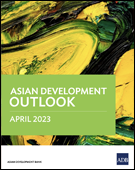 Asian Development Outlook (ADO) April 2023South Asia is projected to grow faster than other subregions in Asia, with real gross domestic product (GDP) estimated at 5.5% in fiscal year (FY) 2023 and 6.1 in FY2024. Growth within South Asia is expected to vary, with India projected to grow by 6.4% in FY2023 and 6.7% in FY2024 behind strong domestic demand. In Bangladesh, GDP growth is estimated at 5.3% in FY2023 owing to global economic disruptions and 6.5% in FY2024. In Bhutan, hydropower production will push up growth to 4.6% in FY2023 and 4.2% in FY2024. Growth in Maldives is estimated at 7.1% in FY2023 and 6.9% in FY2024, supported by a boom in tourism and construction. In Nepal, growth will slow to 4.1% this year before picking up in FY2024 at 5.0% with a recovery in tourism and infrastructure. Sri Lanka is projected to contract at -3.0% in FY2023 before recovering to 1.3% in FY2024 premised on debt relief and key reforms. In Southeast Asia, Myanmar's GDP will rise moderately to 2.8% in FY2023 and 3.2% in FY2024. Author: Asian Development Bank Year: 2023 Download Tags: South Asia, Hydropower, ADB, Bangladesh, Bhutan, India, Maldives, Myanmar, Nepal, Sri Lanka Identifying Challenges and Improving Trade Facilitation in the States of Northeast IndiaThe northeast of India is shares international borders with Bangladesh, Bhutan, Nepal, and Myanmar and acts as a bridge for India's participation in global forums through the Bay of Bengal Initiative for Multisectoral Technical and Economic Cooperation and the South Asia Subregional Economic Cooperation program. This paper highlights challenges in global trade and suggests ways for improving trade with other countries in South Asia and Southeast Asia. Author: Sanchita Basu Das and Soumya Chattopadhyay Year: 2023 Download Tags: India, Trade Facilitation, SASEC, BIMSTEC, Transport, Bangladesh, Bhutan, Nepal, Myanmar Review of Maritime Transport 2022Ships carry over 80% of the volume of global trade. In South Asia, intraregional shipping connections increased as India improved its shipping connections to Pakistan, Sri Lanka, People's Republic of China, the Republic of Korea, Malaysia, Saudi Arabia, Singapore, and the United Arab Emirates. The most connected port in South Asia is the Colombo port in Sri Lanka; the Colombo port ranked the 24th best port in the world in 2021. Author: United Nations Conference on Trade and Development Year: 2022 Download Tags: India, Sri Lanka, Transport, Trade, Global Value Chains Role of Northeast Indian States in Shaping India's Logistics PerformanceThe Government of India launched the National Logistics Policy in 2022 to improve the ease of doing business in the country. The policy integrates infrastructure and network planning and aims to make logistics services and human resources more efficient. This paper explains the current status of logistics and connectivity in India as well as the northeastern region's potential to expand domestic and international trade. The paper also identifies opportunities and initiatives to improve logistics performance. Author: Bijaya Roy and Mihir Shekhar Bhonsale Year: 2022 Download Tags: India, Logistics, Regional Connectivity Significance of Padma Bridge in South Asia's ConnectivityThe Padma Bridge will improve connectivity and increase trade in the Bangladesh. The bridge increases connectivity in Bangladesh and is projected to improve the quality of life among nearby communities. The economies of nearby countries also stand to benefit, as the bridge improves connectivity among Bhutan, India, and Nepal, and improves mobility of people, goods, and essential services. Author: CUTS International Year: 2022 Download Tags: Transport, Trade, BBIN, Bangladesh, Bhutan, India, Nepal World Investment Report 2022 In 2020–2021, foreign direct investment (FDI) in South Asia fell by 26%, to $52 billion, with large mergers and acquisitions from 2020 not repeated in 2021. Flows to Bangladesh rose by 13% to $2.9 billion, while inflows to India declined to $45 billion. However, India announced new international project finance deals, including 23 in renewable energy. Outward FDI from South Asia, mainly from India, rose by 43% to $16 billion. Author: United Nations Conference on Trade and Development Year: 2022 Download Tags: UNCTAD, Trade, South Asia, Bangladesh, India, Renewable Energy 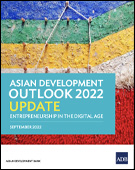 Asian Development Outlook (ADO) 2022 Update: Entrepreneurship in the Digital AgeGrowth forecast in South Asia is projected at 6.5% in fiscal year (FY) 2022 and FY2023. In Bangladesh, gross domestic product (GDP) growth is projected at 7.2% in FY2022 and 6.6% in FY2023, reflecting lower consumption spending. Growth in Bhutan is forecast to grow at 4.5% in FY2022 and 4.0% in FY2023 as government investment continues as a key driver of growth. In India, weaker than expected global demand is expected to affect growth, projected at 7.0% for FY2022 and 7.2% for FY2023. GDP growth in Maldives is forecast at 8.2% in FY2022 and 10.4% in FY2023 with continued tourism arrivals. In Nepal, GDP is projected at 5.8% in FY2022 and 4.7% in FY2023, affected in part by needed policy tightening to address rapid rise in imports. Contractions are projected for Sri Lanka, -8.8% in FY2022 and -3.3% in FY2023, likely resulting from severe macroeconomic challenges, including the impact of the ongoing crisis. In Southeast Asia, Myanmar's GDP is forecast at 2.0% in FY2022 and 2.6% in FY2023 owing to an improvement in economic activity. Author: Asian Development Bank Year: 2022 Download Tags: ADB, Bangladesh, Bhutan, India, Maldives, Myanmar, Nepal  Reshaping Norms: A New Way ForwardSouth Asian countries are emerging from coronavirus (COVID-19) pandemic burdened by high inflation and fiscal imbalances, as well as external shocks. In Bangladesh, gross domestic product (GDP) is projected to increase by 6.4% in fiscal year (FY) 2021-2022 and 6.7% in FY2022-2023. In Bhutan, FY2021-2022 growth is estimated at 4.4% and FY2022-2023 growth at 4.7%, with the expected return of international tourists and migrant workers from India. In India, FY2022-2023 growth is projected at 8%, slightly below last year’s rate. Economic recovery in Maldives will stay strong in 2022, with real GDP growth expected to grow by 8.5% in 2022 and 9.1% in 2023. In Nepal, tourism has yet to recover, with growth projected at 3.7% in FY2021-2022 and 4.1% in FY2022-2023. Hydropower in Nepal is providing a natural hedge against increases in crude oil-based energy prices. Growth in Sri Lanka is hampered by a series of shocks amid high debt, with 2022 growth projected at 2.4%. Author: World Bank Year: 2022 Download Tags: WB, South Asia, Bangladesh, Bhutan, India, Maldives, Nepal, Sri Lanka Basic Statistics 2022Basic Statistics presents economic, environmental, and social indicators used to track progress toward the Sustainable Development Goals. The publication includes new data for development indicators for 46 economies in Asia and Pacific, including those for the seven South Asia Subregional Economic Cooperation countries: Bangladesh, Bhutan, India, Maldives, Myanmar, Nepal, and Sri Lanka. Author: Asian Development Bank Year: 2022 Download Tags: Bangladesh, Bhutan, India, Maldives, Myanmar, Nepal, Sri Lanka, Trade, Sustainable Development Goals, Renewable Energy 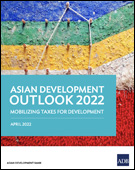 Asian Development Outlook (ADO) 2022: Mobilizing Taxes for DevelopmentGrowth in South Asia is projected to remain strong at 7.0% in FY2022 and 7.4% in FY2023 as the region’s economies try to catch up to pre-pandemic levels. In Bangladesh gross domestic product (GDP) growth is projected at 6.9% in FY2022. Growth in FY2023, projected at 7.1%, will be driven by private consumption. Bhutan is forecast to grow at 4.5% in FY2022. Growth will accelerate to 7.5% in FY2023 with the reopening of international tourism in the country. India is forecast to grow at 7.5% in FY2022 and 8.0% in FY2023, buoyed by strong investment growth. GDP growth in Maldives is forecast at 11.0% in FY2022 and 12.0% in FY2023 with continued tourism arrivals. In Nepal, fiscal stimulus and wider vaccination coverage will support growth, projected at 3.9% in FY2022 and 5.0% in FY2023. Sri Lanka's growth is forecast to slow to 2.4% in FY2022 and pick up to 2.5% in FY2023 amid low foreign exchange reserves. In Southeast Asia, Myanmar’s economy is forecast to contract in FY 2022 on protracted political instability. Myanmar GDP is forecast at -0.3% in FY2022 and 2.6% in FY2023. Author: Asian Development Bank Year: 2022 Download Tags: ADB, Bangladesh, Bhutan, India, Nepal, Sri Lanka, Maldives, Myanmar Regional Cooperation and Integration in Asia and the Pacific: Responding to the COVID-19 Pandemic and "Building Back Better"Platforms for regional and subregional cooperation helped spur collective action to help Asia and the Pacific build back resiliency from the coronavirus disease (COVID-19) pandemic. Regional cooperation platforms such as the South Asia Subregional Economic Cooperation program helped countries respond to the COVID-19 emergency. In South Asia, partners will have the opportunities to support regional market development through transport corridors, trade facilitation, and cross-border energy trade post-COVID-19. Author: Asian Development Bank Year: 2022 Download Tags: ADB, Bangladesh, COVID-19, Economic Corridor Development, Energy, India, Trade Facilitation, SASEC, ADB RCI 2022 , ADB RCI Reforming Port Processes in India for Logistics EfficiencyResearchers undertook port-process mapping at Jawaharlal Nehru and Vishakhapatnam ports, two key export–import gateways in India, to help identify strategic reform and potential solutions to improve port systems in the country. This brief recommends streamlining and digitizing port logistics and operations in India to help reduce logistics cost and make operations more efficient. Author: Asian Development Bank Year: 2021 Download Tags: ADB, India, Customs, ADB RCI Asian Development Outlook 2021 UpdateEconomic growth in South Asia is projected at 8.8% in 2021 while the outlook for next year has been raised to 7.0% from 6.6%. In Bangladesh, growth in fiscal year (FY) 2022 is projected to strengthen though still below pre-coronavirus pandemic levels. In Bhutan, gross domestic product (GDP) in FY2021 is estimated to have contracted by 3.4%; growth is forecast to rebound to 3.7% in FY2022. The projection for India is downgraded to 10.0% from the earlier projection of 11.0% in FY2021, while the outlook for FY2022 improved to 7.5% from 7.0%. Tourist arrivals in Maldives increased by 33.4% year on year in 2021. In Nepal, GDP growth is estimated at 2.3% in FY2021. In Sri Lanka, GDP growth forecasts are revised down to 3.4% in 2021 with risks from fresh pandemic outbreak and currency related stress. Author: Asian Development Bank Year: 2021 Download Tags: ADB, COVID-19, South Asia, Bangladesh, Bhutan, India, Maldives, Sri Lanka World Investment Report 2021Global flows of foreign direct investment fell by one third to $1 trillion in 2020 due to the coronavirus disease (COVID-19) pandemic. In South Asia, foreign direct investments rose by 20% to $71 billion in 2020, driven mainly by strong mergers and acquisitions in India. Inflows in Bangladesh contracted by 11% and in Sri Lanka by 43%, where inflows will take longer to recover. This report monitors global and regional investment trends to support national and international policymakers. Author: United Nations Conference on Trade and Development Year: 2021 Download Tags: COVID-19, Bangladesh, India, Sri Lanka, FDI, South Asia, Sustainable Development Goals, UNCTAD Basic Statistics 2021Basic Statistics 2021 presents development indicators—tracking the progress made by countries in achieving the Sustainable Development Goals. It includes data for 46 economies in Asia and the Pacific, including those for the seven South Asia Subregional Economic Cooperation countries: Bangladesh, Bhutan, India, Maldives, Myanmar, Nepal, and Sri Lanka. Author: Asian Development Bank Year: 2021 Download Tags: Bangladesh, Bhutan, India, Maldives, Myanmar, Nepal, Sri Lanka, Trade, Sustainable Development Goals, Renewable Energy Assam as India's Gateway to ASEANAssam's location in northeast India offers opportunities for enhancing cross-border trade and developing regional economic corridors spanning Bangladesh, Bhutan, India, Nepal, and countries in Southeast Asia. By developing trade and economic corridors, Assam aims to build on its vision of becoming a $75 billion economy by 2025. Author: Asian Development Bank Year: 2021 Download Tags: ASEAN, Bangladesh, Bhutan, India, Nepal, Regional Cooperation, Trade, ADB RCI Harnessing Inland Waterways for Inclusive Trade Among Bay of Bengal CountriesThe transboundary rivers Ganges, Brahmaputra, and Meghna create a vibrant water grid connecting Bangladesh, Bhutan, India, and Nepal. India has been developing fairways and river and multimodal terminals in the last few years. Further development of inland waterways in Bay of Bengal countries would create jobs and open opportunities for inclusive trade. Author: Veena Vidyadharan Year: 2021 Download Tags: Bangladesh, Bhutan, India, Inland Waterways, Nepal, Trade, Transport Reimagining Border Haats as Border Co-prosperity Zones Border Haats have been successful in increasing local livelihoods, improving cross-border microtrade, facilitating people-to-people contact, reducing informal trade, and enhancing border security. This paper argues that establishing border coprosperity zones, coupled with investments in infrastructure and technologies, could help promote connectivity and realize mutual growth and prosperity for Bangladesh and India. Author: Sabyasachi Dutta Year: 2020 Download Tags: Bangladesh, India, Border Haats, Bilateral Trade, Customs COVID-19 and Transport in Asia and the Pacific: Guidance NoteThis guidance note outlines the effects of the coronavirus disease pandemic on the transport sector in developing Asia and the Pacific. In India, for example, rail freight traffic in April and May 2020 had decreased by 28% compared with demand in 2019. The publication shares possible measure for a post-pandemic recovery that provides greener and more resilient recovery. The publication also proposes regional cooperation bodies for coordinating cross-border freight and logistics and international air travel. Author: Asian Development Bank Year: 2020 Download Tags: ADB, Regional Cooperation, India, Transport, Logistics, ADB RCI 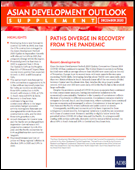 Asian Development Outlook (ADO) 2020 Supplement: Paths Diverge in Recovery from the PandemicThis publication provides updated economic forecasts for Asia and the Pacific. In South Asia, the earlier forecast of 6.8% contraction in 2020 is upgraded to 6.1%. Growth in South Asia is expected to return in 2021 at 7.2%. This is in line with improved prospects for India, where contraction is projected at 8.0% in 2020 and growth is projected at 8.0% in 2021. In Bangladesh, growth in exports and remittances backed economic activity. In Bhutan, the impact of the coronavirus disease (COVID-19) pandemic is expected to be greater than projected. Travel demand remains weak in Maldives and is hampering recovery. In Nepal, a persistent rise in COVID-19 infections holds back demand. Resurgent outbreaks in Sri Lanka’s export and tourist markets are expected to worsen contraction in 2020. Author: Asian Development Bank Year: 2020 Download Tags: South Asia, India, Bhutan, Sri Lanka, Nepal, Bangladesh, Maldives, Tourism, COVID-19, Export India-Bangladesh Coastal Shipping AgreementIn 2015, Bangladesh and India signed an Agreement on Coastal Shipping to promote two-way trade through the countries’ respective ports. Coastal shipping began the following year with MV Harbour 1, which carried a shipment of cotton from Chittagong Port, Bangladesh, to Krishnapatnam Port, India. This short briefing note describes the basic features of the India-Bangladesh Coastal Shipping Agreement and examines complementary initiatives. It discusses the benefits of direct container shipping services, the agreement’s socioeconomic impact, and the issues and challenges associated with the agreement. Author: CUTS International Year: 2020 Download Tags: India, Bangladesh, Trade Reimagining India’s Engagement with BIMSTECThis brief discusses the role that India can play in subregional integration by reimagining India’s economic relations with its Bay of Bengal Initiative for Multi-Sectoral Technical and Economic Cooperation (BIMSTEC) partners. Recent economic developments in the Asia-Pacific region provide context in the analysis presented in this report. By developing local value chains, India can pull the region closer amid competing economic needs. Author: Suparna Karmakar Year: 2020 Download Tags: India, BIMSTEC, Regional Integration Summary of Proceedings of the 53rd ADB Annual Meeting of the Board of GovernorsThe Fifty-Third Annual Meeting of the Board of Governors of the Asian Development Bank (ADB) was held virtually in two stages in May and September 2020. Ms. Nirmala Sitharaman, Minister of Finance, India, called for the establishing of a regular South Asia Subregional Economic Cooperation (SASEC) meeting of finance ministers by 2021 to further strengthen regional cooperation. Mr. Ibrahim Ameer, Finance Minister, Maldives, noted how ADB has assisted Maldives through the SASEC National Single Window Project. Author: Asian Development Bank Year: 2020 Download Tags: SASEC, ADB, India, Maldives, Regional Cooperation, National Single Window Developing Multimodal Logistics Parks in IndiaMultimodal logistics parks (MMLPs) help bring down the cost of logistics and improve logistics performance by providing services in freight aggregation and distribution, multimodal freight transport, integrated storage and warehousing, technology support, and value-added services. This brief from the Asian Development Bank examines the potential of MMLPs to support supply chains in India and discusses the feasibility of MMLPs in Bengaluru and Guwahati. Author: Sabyasachi Mitra, Hoe Yun Jeong, Kavita Iyengar, Bhuwan Bhaskar Agrawal, Shreyans Jain, and Atu Sanganeria Year: 2020 Download Tags: ADB, Bangladesh, India, Logistics, ADB RCI Basic Statistics 2020Basic Statistics presents select economic, environmental, and social indicators used to track progress toward the Sustainable Development Goals. It includes new data for development indicators for 46 economies in the Asia and Pacific region, including those for the seven South Asia Subregional Economic Cooperation countries: Bangladesh, Bhutan, India, Maldives, Myanmar, Nepal, and Sri Lanka. Author: Asian Development Bank Year: 2020 Download Tags: Sustainable Development Goals, Bangladesh, Bhutan, India, Maldives, Myanmar, Nepal, Sri Lanka Enhancing Productivity for Poverty Reduction in India This brief looks at labor productivity in India and its impact on poverty reduction. It notes the need to bridge the infrastructure gap, improve the investment climate, and invest in education. Economic corridors would boost inclusive development, as these would act as markets for goods, help overcome infrastructure and regulatory bottlenecks, and aid dynamic reallocation. One such corridor is the Vizag–Chennai Industrial Corridor, which the Asian Development Bank is supporting with a $631 million loan. Author: Kanupriya Gupta and Abhijit Sen Gupta Year: 2020 Download Tags: ADB, India, Economic Corridor Development Role of Multi-modal Connectivity in Fostering Value Chains in the BBIN Sub-regionThis report looks at how multimodal connectivity can strengthen regional value chains in the Bangladesh, Bhutan, India, Nepal (BBIN) subregion. It also provides a snapshot of various multimodal connectivity initiatives, such as the South Asia Subregional Economic Cooperation (SASEC) Road Connectivity Investment Program, the inland waterways agreement between Bhutan and Bangladesh, and the railway link between Raxaul (India) and Sirsiya (Nepal). Author: CUTS International Year: 2020 Download Tags: Bangladesh, Bhutan, India, Nepal, Rail, Road, Transport, SASEC Asian Development Outlook (ADO) 2020: What Drives Innovation in Asia?Growth in developing Asia is forecast to slow to 2.2% in fiscal year (FY) 2020 due to the effects of the global health emergency. In South Asia, growth will decelerate to 4.1% in FY2020 and rebound to 6.0% in FY2021 following a projected revival in India. Bangladesh is projected to grow by 7.8% this fiscal year and 8.0% in FY2021. GDP growth in Bhutan, despite lower tourist arrivals, will accelerate on high government spending. Growth in Maldives and Sri Lanka will be constrained this year due to weaker tourism. In Nepal, the outlook is for moderating growth. In Southeast Asia, Myanmar growth is expected to slow in FY2020 and pick up in FY2021. Author: Asian Development Bank Year: 2020 Download Tags: ADB, Bangladesh, Bhutan, India, Maldives, Myanmar, Nepal, Sri Lanka, Tourism, FDI 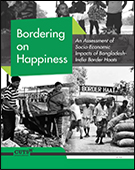 Bordering on Happiness: An Assessment of Socio-Economic Impacts of Bangladesh-India Border HaatsThis study on the border "haats" (market) between Bangladesh and India sought to understand and examine their impact on poverty alleviation. It considers different stakeholders, including vendors, vendees, transporters, laborers, officials, opinion leaders, villagers and residents on both sides of the border, from the four operational border haats between the two countries. It also compares the different trade performances of the four haats and discusses opportunities in each. Participation rate is also tackled, where the impact of transportation options or lack thereof on the regularity of attendance is discussed. The study has found that areas with border haats have formalized many informal trade. These have generated income and employment, benefiting local people positively and improving standards of living. They have also enhanced trade opportunities by offering vendors access to new markets, as well as a source of products they can resell in their own countries. Furthermore, border haats have promoted improved cross-border relations and security, and people-to-people connectivity. The study recommends further policy improvements to border haats, such as encouraging more women participation and upgrading common infrastructure that makes people-to-people connectivity more conducive. Author: CUTS International Year: 2019 Download Tags: Border Haats, India, Bangladesh Achieving Energy Security in Asia: Diversification, Integration and Policy ImplicationsThis publication reviews the status of energy security in Asia. In South Asia, countries face challenges in achieving energy security and climate goals. India and Bangladesh, for instance, face rising energy import bills while Maldives depends on oil products. The book suggests that countries and regions can achieve energy security through energy cooperation and diversification. This would lead to economic growth and poverty reduction, as well as mitigate energy security risks from climate change. Author: Asian Development Bank Institute and World Scientific Year: 2019 Download Tags: WB, India, Bangladesh, Maldives, Energy, Climate Change Integrated Check-Posts on the India-Bangladesh Border: a Field Survey and Brief AnalysisIntegrated Check-Posts (ICPs) are designed to be one-stop solutions that house all regulatory agencies, including immigration, customs, and border security. India is in the process of establishing ICPs to efficiently manage crossings along its land borders. The country has identified 20 checkpoints for development as ICPs, including 10 that are on the India–Bangladesh border. This report studies the impact of the ICPs on activities along the India-Bangladesh border and suggests ways to improve efficiency of ICPs. Author: Joyeeta Bhattacharjee Year: 2019 Download Tags: Bangladesh, Customs, Trade Facilitation, India 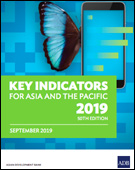 Key Indicators for Asia and the Pacific 2019This report presents the latest economic, financial, social, and environmental statistics, and includes sustainable development goals indicators, for the 49 regional members of the Asian Development Bank (ADB). Remittances have been a stable source of revenue for Asia and the Pacific, with India being the top recipient of remittances globally at $78.6 billion in 2018. In 2017, foreign direct investment (FDI) in the region rose to $541.9 billion, although FDI flows have been more volatile compared to remittance flows. This report uses domestic value-added via forward linkages (DVA_F) to discuss the evolution of global value chains in Asia. In 2018, almost a third of the DVA_F generated in Asia stayed within the region, representing 39.0% of the total domestic value-added sent to the region. It shows the importance of intraregional trade for Asia, as Asia's trade connection to North America is weakening. Author: Asian Development Bank Year: 2019 Download Tags: ADB, India, South Asia, Sustainable Development Goals, Trade Bountiful Bangladesh: An Ocean of OpportunitiesThis special publication by the Bangladesh High Commission, New Delhi, India, celebrates India-Bangladesh relations. A chapter on regional cooperation discusses how prosperity is promoted in the region through the South Asia Subregional Economic Cooperation (SASEC). Progress in regional cooperation builds on the momentum generated in the last 18 years through SASEC. Economic performance has been impressive and South Asia is forecast to become the fastest growing subregion in Asia. Author: Bangladesh High Commission, New Delhi, India Year: 2019 Download Tags: Bangladesh, India, SASEC, Regional Cooperation South Asia: Shifting Outlook Calls For Steadfast ReformsGrowth in South Asia is projected to rise to 7.0% in 2020. To create more and better jobs, the region needs to further strengthen reforms. Growth in Bangladesh is expected to remain strong at around 8.0% in fiscal year (FY) 2019, led by private consumption and investment. In Bhutan, economic activity will pick up to around 6.0% in FY2020, supported by private consumption. In India, gross domestic product (GDP) growth slowed to 6.8% in FY2018/2019. Economic activity in Nepal remains robust as FY2018/2019 growth reached 7.1%. In Maldives, growth has been supported by increasing tourist arrivals. Economic activity in Sri Lanka is projected to recover as the tourism sector stabilizes. Author: International Monetary Fund Year: 2019 Download Tags: Bangladesh, Bhutan, India, Maldives, Nepal, Sri Lanka, Investment, Jobs, Tourism Borders without Barriers: Facilitating Trade in SASEC CountriesBorders without Barriers presents an analysis of the state of trade facilitation in member countries of the South Asia Subregional Economic Cooperation (SASEC) program. The book includes an analysis of the state of trade facilitation in Bangladesh, Bhutan, India, Nepal, and Sri Lanka, as well as in Maldives and Myanmar. It identifies trade facilitation priorities in SASEC countries: implementation of trade facilitation agreements and other conventions; logistics and infrastructure development and regulatory reforms; coordinated border management; and institutions and capacity development. Author: Asian Development Bank Year: 2019 Download Tags: ADB, SASEC, Trade Facilitation Agreement, Bangladesh, Bhutan, India, Maldives, Myanmar, Nepal, Sri Lanka, ADB RCI Bridging the East: Trade and Transport Connectivity in the Bay of Bengal RegionBangladesh, Bhutan, India, and Nepal Motor Vehicles Agreement aims to reap the trade and economic potentials of the countries of South Asia. This study identifies hurdles to the successful implementation of the agreement through evidence-based advocacy and dialogue. The study highlights issues related to infrastructure, political economy, gender, and livelihood. Author: CUTS International Year: 2019 Download Tags: Trade, Transport, BBIN, BBIN Motor Vehicles Agreement, Bangladesh, India, Bhutan, Myanmar, Nepal 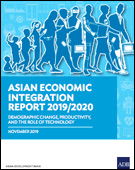 Asian Economic Integration Report 2019/2020: Demographic Change, Productivity, and the Role of TechnologyThis report reviews economic cooperation and integration in Asia and the Pacific. It reports that in 2018, the South Asia Subregional Economic Cooperation (SASEC) focused on reducing gaps in multimodal connectivity among its member countries. By the end of 2018, 52 ADB-financed projects worth $11.36 billion had been committed to SASEC projects, with an additional $106.44 million in 81 technical assistance grants. SASEC nodal officials and working groups met in Singapore in March 2018 to update the SASEC operational plan. The operational plan identified 77 projects ($45.6 billion) to be financed by SASEC members, ADB, and development partners. A holistic approach under the operational plan will build transport links with Southeast Asia and East Asia and expand regional trade markets. Author: Asian Development Bank Year: 2019 Download Tags: ADB, Regional Cooperation, SASEC, Trade Facilitation, Transport, Bangladesh, Bhutan, India, Maldives, Myanmar, Nepal, Sri Lanka Maritime Cooperation in SASEC: South Asia Subregional Economic CooperationMost South Asia Subregional Economic Cooperation (SASEC) countries rely on maritime transport for international trade. Stronger maritime relations are crucial to achieve the economic growth potential for the subregion. This report looks at how countries can strengthen international trade by improving maritime cooperation among the SASEC countries, comprised of Bangladesh, Bhutan, India, Maldives, Myanmar, Nepal, and Sri Lanka. It gives an overview of the SASEC maritime sector and identifies collaboration initiatives that could address key challenges. Author: Asian Development Bank Year: 2019 Download Tags: Transport, Trade Facilitation, Bangladesh, Bhutan, India, Maldives, Myanmar, Nepal, Sri Lanka, ADB RCI Asian Development Outlook (ADO) 2019 Update: Fostering Growth and Inclusion in Asia's CitiesGrowth in developing Asia remains strong despite the slowing down of international trade and a weakening of investments. In South Asia, growth momentum has slowed, with growth forecasts lowered to 6.2% for 2019 and retained at 6.7% for 2020. Growth in India has softened but is expected to bounce back to 7.2% in 2020. Bangladesh and Nepal performed better than projected. Bhutan’s growth slowed to 5.3% in fiscal year (FY) 2019 due to a decline in hydroelectric generation. Growth projection for FY2020 is retained at 6.0%. In Sri Lanka, growth forecast has been lowered for 2019 and 2020. Forecasts for Maldives is retained as tourist arrivals increased in the first half of 2019. In Southeast Asia, growth projections for Myanmar has been retained. Author: Asian Development Bank Year: 2019 Download Tags: Hydropower, ADB, Bangladesh, Bhutan, India, Maldives, Myanmar, Nepal, Sri Lanka World Investment Report 2019This report monitors global and regional foreign direct investment trends and national and international investment policy developments. Foreign direct investments (FDI) in South Asia grew by 4% in 2018 to $54 billion, with India accounting for $42 billion. International cooperation in the development of special economic zones (SEZs) has been increasing. In developing countries, many SEZs are built through bilateral partnerships or as part of development cooperation programs. In South Asia, the number of SEZs is set to increase substantially. India has 200 new zones in the pipeline, while Bangladesh has 60, and Nepal 12. Author: United Nations Conference on Trade and Development Year: 2019 Download Tags: Bangladesh, India, Nepal, FDI, Investment, South Asia, UNCTAD Basic Statistics 2019Basic Statistics presents select economic, environmental, and social indicators used to track progress toward the Sustainable Development Goals. It includes indicators for development indicators for 46 economies in the Asia and Pacific region, including those for the seven SASEC countries: Bangladesh, Bhutan, India, Maldives, Myanmar, Nepal, and Sri Lanka. Author: Asian Development Bank Year: 2019 Download Tags: Bangladesh, Bhutan, India, Maldives, Myanmar, Nepal, Sri Lanka, Trade, Sustainable Development Goals, Energy Economic and Social Survey of Asia and the Pacific 2019: Ambitions beyond GrowthThe Asia-Pacific region needs an estimated $1.5 trillion per year to end poverty and hunger, provide basic health care, quality education, enabling infrastructure, and clean energy for all, and for climate action and living in harmony with nature. Available public and private resources make these ambitions affordable for most countries in the region. However, development partnerships and regional cooperation are needed for all countries to achieve these “ambitions beyond growth.” Author: United Nations Economic and Social Commission for Asia and the Pacific Year: 2019 Download Tags: Sustainable Development Goals, Bangladesh, Bhutan, India, Nepal, Maldives, Myanmar, Sri Lanka, Trade, Energy Connecting Corridors beyond Borders: Enabling Seamless Connectivity in the BBIN Subregion Trade connectivity is expected to bring economic growth and prosperity and reduce poverty in Bangladesh, Bhutan, India, and Nepal (BBIN). It will strengthen the economies of landlocked Bhutan and Nepal and give BBIN countries greater access to global markets for exports and imports. The Motor Vehicles Agreement will promote containerization of multimodal cargo movement, which will help reduce trade costs. This study identifies eight trade corridors in the BBIN countries and provides details on existing infrastructure, time-cost-distance analysis, and projected sociopolitical impact. Author: CUTS International Year: 2019 Download Tags: BBIN, BBIN Motor Vehicles Agreement, Transport, Bangladesh, Bhutan, India, Nepal Impact Evaluation of Energy Interventions: A Review of the EvidenceImpact evaluations in the energy sector has so far focused on rural electrification and improved cookstoves. However, most investments have been in power generation and transmission. This energy sector impact evaluation report assesses what has been produced against what might be possible. It summarizes outcomes of 85 impact evaluations of energy interventions in developing countries, including Bangladesh, Bhutan, India, and Nepal. It looks at evidence gaps and proposes future directions for impact evaluations in the energy sector. Author: David A. Raitzer, Nina Blöndal, and Jasmin Sibal Year: 2019 Download Tags: Energy, Bangladesh, Bhutan, Nepal, India 2018 Development Effectiveness ReviewThis report looks at the Asian Development Bank’s (ADB) performance in achieving the goals set out in ADB’s Strategy 2020. In its South Asia operations, ADB supported the linking of countries through transport connectivity. ADB has committed $180 million to rehabilitate the Kanchanpur–Kamala section of the East–West Highway in Nepal to promote safety and transport connectivity. It is also committed to a $150 million project through the South Asia Subregional Economic Cooperation Road Connectivity Investment Program to upgrade a section of the Asian Highway connecting Manipur, India, to Myanmar and construct an international bridge between India and Nepal. Author: Asian Development Bank Year: 2019 Download Tags: ADB, India, Jobs, Myanmar, Nepal, SASEC, Transport, Road Impact Evaluation of Transport Interventions: A Review of the EvidenceDevelopment of transport is integral to the development of economic corridors, regional economic integration, and trade. This publication reviews the impact of 91 transport interventions in developing countries, including Bangladesh, Bhutan, India, and Nepal. It summarizes the project outcomes, identifies evidence gaps, and presents proposals for future directions. Author: David A. Raitzer, Nina Blöndal, and Jasmin Sibal Year: 2019 Download Tags: Bangladesh, Regional Connectivity, Bhutan, India, Nepal, Rail, Road, Transport Renewable Capacity Statistics 2019This report provides renewable energy statistics for 2009–2018. It includes figures on total renewable energy capacity installed and connected by energy source (hydropower, wind energy, solar energy, etc.). It gives figures for capacity per region and per country, including those for Bangladesh, Bhutan, India, Maldives, Myanmar, Nepal, and Sri Lanka. Author: International Renewable Energy Agency Year: 2019 Download Tags: Renewable Energy, Bangladesh, Bhutan, India, Maldives, Myanmar, Nepal ADB Annual Report 2018The Asian Development Bank (ADB) supports cross-border infrastructure to help foster regional cooperation and integration. It is transforming transport corridors into economic corridors, allowing South Asian countries to participate in regional and global value chains and promote agriculture trade. In 2018, ADB committed $150 million to upgrade sections of South Asia Subregional Economic Cooperation (SASEC) road corridors in India and Nepal. The investments aim to improve connectivity between Manipur (in India) and Myanmar; build an India–Nepal international bridge; and improve the safety of Nepal’s East–West Highway. ADB also approved a technical assistance project to build institutional capacity and improve expertise of trade facilitation officials in SASEC member countries. Author: Asian Development Bank Year: 2019 Download Tags: Economic Corridor Development, ADB, Energy, India, Nepal, SASEC, Trade Facilitation Asian Development Outlook (ADO) 2019: Strengthening Disaster ResilienceDeveloping Asia is projected to grow at 5.7% in 2019 and 5.6% in 2020. South Asia is projected to bounce back in 2019 and 2020 from the previous year’s slowdown. India’s growth is expected to pick up to 7.2% in 2019 (from 7.0% in the previous year) on recovery in agriculture and strong domestic demand. Bangladesh is projected to grow by 8.0% in 2019. Bhutan is expecting modest growth while the outlook for Maldives is for growth to moderate. Nepal should expect stable growth in 2019 while Sri Lanka is projected to recover moderately. Inflation in South Asia is projected to rise to 4.7% in 2019. Growth should pick up in Myanmar in Southeast Asia. Author: Asian Development Bank Year: 2019 Download Tags: ADB, South Asia, Bangladesh, Bhutan, India, Myanmar, Maldives, Nepal, Sri Lanka World Energy Outlook 2018Electricity demand is doubling in developing economies, led by India. This makes cleaner and affordable electricity central to economic development and emissions reduction. This report analyzes different pathways across various fuels and technologies. It looks at policies that could help reduce air pollution and meet global energy and climate goals. Author: International Energy Agency Year: 2018 Download Tags: Energy, India, Renewable Energy What Does It Cost to Trade Cross-Border?Customs duties, local taxes, and customs clearance increase trade costs and serve as obstacles for many small and medium enterprises. This paper explores challenges these enterprises face in using e-platforms and trading internationally. It looks at de minimis exemptions (the minimum value of goods below which no duties are collected) in India and other economies and analyzes the impact of these exemptions on exports by micro and small enterprises. Author: Sanjay Kumar Mangla Year: 2018 Download Tags: India, Trade Facilitation Asian Development Outlook 2018 Supplement: The Outlook Firms as Trade Conflict PausesGrowth forecasts for developing Asia stand at 5.8% in 2019. South Asia is still the fastest-growing subregion in developing Asia, while 2019 forecasts are revised down marginally at 7.1%. Bangladesh maintains its growth momentum with the expansion of exports and remittances. Growth in Bhutan has moderated while tourist arrivals grew strongly in Maldives. India exports are increasing along with the country’s industrial and agricultural output. GDP in Sri Lanka grew by 3.7% amid revived private consumption. In Nepal, exports surged by 16.1% while remittances grew to a record $2.1 billion. Author: Asian Development Bank Year: 2018 Download Tags: ADB, Bangladesh, Bhutan, India, Maldives, Nepal, Sri Lanka Investment Climate Improvement in East Coast Economic Corridor of India: Regulatory, Institutional, and Policy Reforms Support to Tamil NaduThis paper summarizes a study that the Asian Development Bank (ADB) undertook upon the request of the Government of Tamil Nadu, India. The state sought to become a preferred investment destination with an investor-friendly business climate. The study identified policy, institutional, and process reforms to improve the ease of doing business in Tamil Nadu, including institutional and regulatory reforms needed for the East Coast Economic Corridor (ECEC) development. The study resulted in the implementation of an online single window mechanism that simplified and sped up processes for transparent and time-bound clearances for investors. Author: Asian Development Bank Year: 2018 Download Tags: ADB, Ease of Doing Business, Economic Corridor Development, India, Single Window, ADB RCI 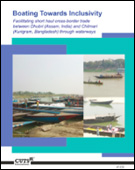 Boating Towards Inclusivity: Facilitating Short Haul Cross-border Trade between Dhubri (Assam, India) and Chilmari (Kurigram, Bangladesh) through WaterwaysIndia and Bangladesh use inland waterways to trade goods, mainly through three routes. The most active route is a portion of Protocol Route 1 between Kolkata, India, and Narayanganj, Bangladesh. This paper by Consumer Unity and Trust Society (CUTS) International explores how cross-border trade may be expanded along the stretch between Dhubri, India, and Chilmari, Bangladesh. Opening the route to small mechanized boats would offer livelihood opportunities to boat pilots, boat builders, vendors, small traders. Farmers will also have access to new markets across the border. The study highlights the need for an inclusive developmental approach that encourages cooperation in trade and connectivity and benefits marginalized communities. Author: Saurabh Kumar, Susan Mathew, and Veena Vidyadharan Year: 2018 Download Tags: Transport, India, Bangladesh, Trade, Connectivity World Investment Report 2018In India, foreign direct investment (FDI) inflows dropped from $44 billion in 2016 to $40 billion in 2017. Across South Asia, FDI inflows are predicted to stagnate or decline marginally in 2018. The global trend in FDI flows demonstrates the need for open, transparent, and non-discriminatory investment policies to maintain an environment conducive for investment. New types of industrial policies are emerging to respond to opportunities and challenges brought about by a new industrial revolution. This report examines investment policy tools available in the new environment. Author: United Nations Conference on Trade and Development Year: 2018 Download Tags: Connectivity, FDI, Global Value Chains, India, Investment, Policy, Sustainable Development Goals, South Asia, UNCTAD Infrastructure Financing in South AsiaSouth Asia is the world's fastest-growing region. The region has also shown significant reduction in poverty and income inequality owing to improved road transport, electricity, and sanitation. The growth is attributed partly to the improvement in infrastructure in Bangladesh, India, and Sri Lanka. Yet, to sustain growth and deal with climate change, the region must invest more to develop infrastructure in the next 15 years. This paper looks at public and private sector financing of infrastructure and discusses the factors driving infrastructure investment. Author: Shikha Jha and Rosa Mia Arao Year: 2018 Download Tags: Bangladesh, India, Sri Lanka, Energy, ICT, Infrastructure, Public Private Partnerships, Transport Reinvigorating Trade and Inclusive GrowthThis report offers insights into how trade benefits the poor, those in rural areas, micro, small, and medium-sized enterprises, and women. It also shows how productivity and living standards could be raised through greater openness in key areas, such as services trade and e-commerce. The report goes on to suggest that trade policies should aim to build greater openness and urge countries to reinvest in open, rules-based global trade. Author: International Monetary Fund, World Bank, and the World Trade Organization Year: 2018 Download Tags: India, Regional Cooperation, Trade Facilitation Agreement, WTO Key Indicators for Asia and the Pacific 2018This report presents the latest economic, financial, social, and environmental statistics for the 48 regional members of the Asian Development Bank (ADB). In 2017, foreign direct investment flows to developing Asia was stable, with 8.8% going to South Asia; energy gains were made in five of six countries in South Asia; and starting a business continues become easier in most developing ADB member economies following lowered regulatory costs and simplified compliance procedures. Nepal and Armenia experienced the most rapid annual growth rate at 7.5%, while India witnessed a 6.7% growth in GDP. Author: Asian Development Bank Year: 2018 Download Tags: ADB, Energy, Transport, Bangladesh, Bhutan, India, Maldives, Nepal, Southeast Asia, Sri Lanka BBIN: Opportunities and ChallengesThe Bangladesh, Bhutan, India, and Nepal (BBIN) initiative focuses on establishing connectivity, which have helped foster regional trade and improve sustainable resource management. This publication contains discussions held at the Young Thinkers' Conference, entitled "BBIN: Opportunities and Challenges," held in 2017 in Kolkata, India. The section "Strengthening Connectivity in the BBIN" looks at how connectivity in the subregion could be increased through several measures that address a number of logistical handicaps. "BBIN: The Way Ahead" examines the need for cooperation among the countries to achieve collective growth. Author: Anasua Basu Ray Chaudhury et al Year: 2018 Download Tags: Bangladesh, BBIN, Bhutan, India, Nepal BIMSTEC and Japan: Exploring Prospects for Renewed CooperationThe Bay of Bengal region is rising as an economic and strategic hub, with the Bay of Bengal Initiative for Multi-Sectoral Technical and Economic Cooperation (BIMSTEC) playing a key role in promoting growth and development in the region. BIMSTEC is also being seen as a potential driver of integration between South Asia and Southeast Asia. Given Japan's relationship with BIMSTEC nations, this brief makes a case for deeper engagement between Japan and BIMSTEC. The benefits could include cooperation in infrastructure, connectivity, and energy projects. A free trade agreement between the two entities would also be mutually beneficial. Author: Vindu Mai Chotani Year: 2018 Download Tags: ASEAN, Bangladesh, Bhutan, BIMSTEC, Connectivity, India, Myanmar, Nepal, Sri Lanka, Free Trade Agreements Asian Development Outlook (ADO) 2018 Update: Maintaining Stability Amid Heightened UncertaintyThis Update forecasts 6.0% growth for the region in 2018 and 5.8% in 2019. In South Asia, economic outlook remains optimistic. The region is expected to sustain its growth momentum, and meet projections of 7.0% in 2018 and 7.2% in 2019. Forecast for India is maintained at 7.3% in 2018 and 7.6% in 2019. Robust investment climate in Bangladesh is driving projections from 7.0% to 7.9% in 2018 and 7.2% to 7.5% in 2019, and in Nepal, from 4.9% to 5.9% in 2018. A drop in domestic demand lowers growth projections for Bhutan, from 7.1% to 6.7% in 2018 and 7.4% to 7.1% in 2019, and Sri Lanka, from 4.2% to 3.8% in 2018 and 4.8% to 4.5% in 2019. Author: Asian Development Bank Year: 2018 Download Tags: South Asia, India, Bangladesh, Nepal, Sri Lanka, ADB, Bhutan Connecting to Compete 2018: Trade Logistics in the Global EconomyConnecting to Compete summarizes the findings from the latest data from the 2018 Logistics Performance Index (LPI) and its six component indicators. The book aims to help countries frame policies by looking at supply chain performance and constraints in 100 countries, using data on time, distance and reliability; and ratings on domestic infrastructure quality, services, and border agencies. Among lower-middle-income countries, India stands among the top performers with an LPI score of 3.18 and ranked 44th. Author: Arvis et al. Year: 2018 Download Tags: India, Logistics Asian Development Outlook 2018 Supplement: The Outlook Remains Stable South Asia continues to be the fastest expanding subregion, with growth on track to achieve forecasts of 7.0% in 2018 and 7.2% in 2019. India will meet April forecasts of 7.3% in 2018 and 7.6% in 2019. Owing to strong agricultural growth in Bangladesh and industry growth in Nepal, 2018 GDP growth in the two countries surpassed earlier forecasts. Decline in construction slowed Sri Lanka’s economic growth to 3.2% while hydropower production was lower than forecast in Bhutan. Cement, wood, and metal imports grew in Maldives. Author: Asian Development Bank Year: 2018 Download Tags: ADB, Bangladesh, Bhutan, Energy, Hydropower, India, Maldives, Nepal, Sri Lanka Basic Statistics 2018Basic Statistics presents development indicators for 45 economies in the Asia and Pacific region, including those for the seven SASEC countries, Bangladesh, Bhutan, India, Maldives, Myanmar, Nepal, and Sri Lanka. It presents selected core indicators such as international and national poverty rates, inflation, and current account balance. It also presents information on indicators related to land, population, sustainable development goals, national accounts, money, balance of payments, reserves, external debt, and central government finance. Author: Asian Development Bank Year: 2018 Download Tags: Energy, ADB, Trade, Sustainable Development Goals, Bangladesh, Bhutan, India, Maldives, Myanmar, Nepal, Sri Lanka East Asia Pacific Economic Update, April 2018: Enhancing PotentialEast Asia and Pacific (EAP) grew slightly faster than anticipated in 2017, with growth in Myanmar rebounding slightly at 6.4% due to strong exports. Amid risks to macroeconomic stability, EAP countries must enhance trade facilitation and integration, improve education systems, and upgrade capabilities of workers and managers. Author: World Bank Year: 2018 Download Tags: Exports, GDP, India, Manufacturing, Myanmar, Poverty Reduction, Trade Facilitation, WB Global Energy Transformation: A Roadmap to 2050The report details the needed energy technologies and analyzes the costs and benefits of energy transition in Asia and the rest of the world. All regions are projected to experience high growth in gross domestic product from the energy transformation. Mexico, Brazil, and India are expected to post the highest welfare gains, where pollution’s impact on health is projected to fall sharply. To accelerate the energy transition, governments could establish more bilateral and multilateral demonstration projects and encourage development of internationally harmonized technical standards to facilitate cross-border trade and exchange of technologies. Author: International Renewable Energy Agency Year: 2018 Download Tags: Climate Change, Renewable Energy, India, South Asia Asian Development Outlook (ADO) 2018: How Technology Affects JobsDeveloping Asia is forecast to expand by 6.0% in 2018 and 5.9% in 2019. Growth in South Asia is expected to be revived after a two-year slowdown. India is expected to bounce back to 7.3% in 2018 and 7.6% in 2019 owing to the effects of tax and banking reforms and corporate deleveraging. Growth will be strong in the rest of South Asia, with a forecast of 7.0% in 2018 and 7.2% in 2019, but expansion will be affected in Bangladesh and Sri Lanka following a need to carry out revenue-enhancing fiscal reform and to strengthen economic policy. Inflation forecast in South Asia is 4.7% in 2018 and raised to 5.1% in 2019. Author: Asian Development Bank Year: 2018 Download Tags: ADB, Bangladesh, Bhutan, India, Employment, Jobs, Maldives, Myanmar, Nepal, Sri Lanka, Technology Renewable Capacity Statistics 2018This publication provides statistics on renewable power generation capacity for the last decade. It gives figures for global capacity, capacity per region, and capacity per country, including those for Bangladesh, Bhutan, India, Maldives, Myanmar, Nepal, and Sri Lanka. Figures include those for total energy generation capacity, total renewable capacity, and capacity by energy source (hydropower, wind energy, solar energy, etc.). Author: International Renewable Energy Agency Year: 2018 Download Tags: Hydropower, Renewable Energy, Bangladesh, Bhutan, India, Maldives, Myanmar, Nepal, Sri Lanka Trade Rules in E-commerce: WTO and IndiaRegulations for e-commerce is evolving in India and the rest of the world. This paper traces the growth of the e-commerce sector in India, developments in the WTO, and India’s position. It finds that while trade rules in India are more liberal than in other countries, India needs to address gaps and inconsistencies in the regulations. It also recommends that India join the negotiations on trade rules. Author: Arpita Mukherjee and Avantika Kapoor Year: 2018 Download Tags: ADB, India, Trade Facilitation Agreement, WTO Fostering Effective Energy TransitionThis report introduces the Energy Transition Index, which looks at the performance of energy systems in 114 countries and their readiness to transition to a secure, sustainable, affordable, and inclusive future energy system. The report shows that India has been improving electricity access. It also encourages countries to benchmark themselves against comparable groups in terms of development status and energy trade balance to identify best practices and develop applicable improvement plans. Author: World Economic Forum Year: 2018 Download Tags: Energy, India, Trade Trade Facilitation and Innovation: Evidence from South Asia Subregional Economic Cooperation CountriesThis paper looks at trade and its effects on innovation. Its analysis of firm-level data from Bangladesh, India, and Nepal shows that shorter trade times add competitive pressure from world markets and induces firms to innovate, hence associated with introduction of new products and new management systems. The results suggest that policies that improve trade facilitation would support long-term growth in South Asia Subregional Economic Cooperation countries. Author: Ben Shepherd, Utsav Kumar, and Roselle Dime Year: 2018 Download Tags: Bangladesh, India, Nepal, SASEC, Trade Facilitation Agreement, WTO, ADB RCI Transport Corridors and their Wider Economic Benefits: A Critical Review of the LiteratureThis paper reviews literature estimating the impact of large transport investments. It reviews 78 studies, 11 of which centers on infrastructure projects in India. The paper looks at the economic benefits of transport infrastructure projects to better understand how corridors could generate wider economic benefits, with a focus on roads, rails, and waterways. The review assesses the impact of transport corridor projects on economic welfare and equity, environmental quality, and social inclusion, and suggests a need for policies and institutions that address trade-offs. Author: Mark Roberts, Martin Melecky, Theophile Bougna, and Yan Sarah Xu Year: 2018 Download Tags: Economic Corridor Development, India, Infrastructure, Investment, Railway, Roads, Transport, WB ADB Annual Report 2017The Asian Development Bank (ADB) 2017 Annual Report details ADB’s operations, activities, and financial results over the year. In South Asia, finance ministers from South Asia Subregional Economic Cooperation (SASEC) member countries launched the SASEC Vision, which sets a long-term strategy for inclusive growth for the region. ADB also signed seven SASEC projects worth a combined $1.33 billion, bringing SASEC’s cumulative investment portfolio to $10.72 billion. ADB helped form SASEC working groups for cross-border trade and supported economic corridors in Bangladesh, India, and Sri Lanka to facilitate trade and investment in South Asia. Author: Asian Development Bank Year: 2018 Download Tags: ADB, Bangladesh, Bhutan, India, Regional Cooperation, SASEC, South Asia Global Investment Competitiveness Report 2017/2018: Foreign Investor Perspectives and Policy ImplicationsThis report provides analytical insights and empirical evidence on foreign direct investment’s (FDI) drivers and contributions to economic transformation. Data are categorized by sector and geographic origin and destination of investment, including analysis for SASEC countries using data for Bangladesh, Bhutan, India, Myanmar, Nepal, and Sri Lanka. The report explores the potential of FDI to create growth for local firms, assesses the effectiveness of fiscal incentives in attracting FDI, and gives practical recommendations to developing countries. Author: World Bank Group Year: 2018 Download Tags: Bangladesh, Bhutan, FDI, India, Nepal, Sri Lanka, Trade, WB, Myanmar Services and Global Value Chains: The Asia-Pacific Reality, Studies in Trade, Investment and Innovation 89This book reviews issues concerning the roles of services in global value chains. It presents a framework for assessing links among different services and between services and the manufacturing sector. The book explains the contribution of services to global value chains in the Asia-Pacific region and to the world and also draws lessons with which countries could understand the importance of services and participation in global value chains to achieving sustainable development. Author: Witada Anukoonwattaka, Mia Mikic, Yuhua Zhang Year: 2017 Download Tags: ASEAN, Asia-Pacific, Energy, Global Value Chains, India, Nepal, Regional Cooperation, Sri Lanka, Sustainable Development, Sustainable Development Goals, Trade Facilitation, UNESCAP Harmonizing Electricity Laws in South AsiaMany in South Asia face electricity shortages that affect their socioeconomic development. But the region has a large hydropower potential and other energy resources that may be harnessed to drive growth in the region. This report looks at legal, regulatory, technical, and commercial requirements for energy trade to advance in the region, and gives recommendations for implementing the South Asian Association for Regional Cooperation Framework Agreement on Energy Trade. Author: Asian Development Bank and the South Asian Association for Regional Cooperation in Law Year: 2017 Download Tags: Bangladesh, Bhutan, Energy, Harmonisation, India, Industrialization, Maldives, Nepal, Regional Cooperation, South Asia, Sri Lanka, Trade, ADB RCI World Energy Outlook 2017This report looks at large-scale shifts in the global energy system, such as the the growing electrification of energy and the rise of renewables, and discusses how these shifts interact with each other. It also examines how India and other major developing countries are blurring the distinctions between energy producers and consumers. Author: International Energy Agency Year: 2017 Download Tags: Energy, India, Renewable Energy, Renewables SME Guide to Value ChainsThis is a guide for small and medium enterprises (SMEs), providing insights on entering international value chains and building business relationships. It discusses compliance with standards and regulations, contractual relationships, production and performance management, and strategies for diversification. It features success stories of small companies from India and other countries, illustrating how these companies became regional or global leaders. Author: International Trade Centre Year: 2017 Download Tags: Global Value Chains, India, Small and Medium Enterprise Digital Trade Facilitation in Asia and the Pacific: Studies in Trade, Investment and InnovationDigital trade facilitation is reducing trade costs for developing economies, allowing them to use trade as an engine of growth and sustainable development. This report provides an overview of trade facilitation and paperless trade implementation in the Asia-Pacific region. It analyzes the impact on trade costs of trade facilitation measures and reviews paperless trade provisions in recent regional trade agreements. Among the countries surveyed are Bangladesh, Bhutan, India, Maldives, Nepal, and Sri Lanka. Author: United Nations Economic and Social Commission for Asia and the Pacific Year: 2017 Download Tags: Bangladesh, Bhutan, India, Maldives, Nepal, Sri Lanka, Trade Facilitation Agreement, WTO Trade and Trade Facilitation along the Belt and Road Initiative CorridorsThis paper reviews the current state of trade and trade facilitation among the countries along the six corridors under the Belt Road Initiative (BRI), and looks at the potential impact of infrastructure development on trade. It explores at the Bangladesh-China-India-Myanmar (BCIM) corridor, and reviews trade growth, tariff rates, logistics performance index, ease of trading across borders, and other indicators in those countries. Author: Bala Ramasamy, Matthew Yeung, Chorthip Utoktham, and Yann Duval Year: 2017 Download Tags: Bangladesh, Economic Corridor Development, India, Myanmar, Trade Facilitation SME Competitiveness Outlook 2017 – The Region: A Door to Global TradeThe most common form of trade for small and medium-sized enterprises (SMEs) is regional trade. This report shows that regional trade agreements deliver inclusive growth, attracting value chain activity and fostering competitiveness for small firms. It provides advice for policymakers, businesses, and trade and investment support institutions. The report also includes 50 country profiles—including those of Bangladesh, Bhutan, India, Nepal, and Sri Lanka—showing SME competitiveness and export potential by region. Author: International Trade Centre Year: 2017 Download Tags: Small and Medium Enterprise, Trade, Bangladesh, Bhutan, India, Nepal, Sri Lanka Asia-Pacific Trade and Investment Report 2017: Channelling Trade and Investment into Sustainable DevelopmentThis report provides analyses of trends and policy developments in trade in goods and commercial services in Asia-Pacific. It shows that merchandise trade remained subdued in 2016, with South and Southwest Asia accounting for 8% of Asia-Pacific exports and 12% of Asia-Pacific imports. Foreign direct investments inflows In South and South-West Asia decreased slightly by 4% to $66 billion in 2016. The report also argues for targeted trade and investment policies that strike a balance between economic development and social and environmental development. Author: United Nations Economic and Social Commission for Asia and the Pacific Year: 2017 Download Tags: Trade, Investment, FDI, ASEAN, India, Services, South Asia, Sri Lanka, Sustainable Development Goals, UNESCAP 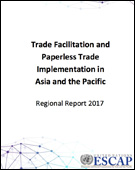 Trade Facilitation and Paperless Trade Implementation in Asia and the Pacific - Regional Report 2017Paperless trade reduces trade costs and enables trade to drive growth and sustainable development. This report shares results of the global survey on trade facilitation and paperless trade implementation, covering 44 countries in Asia and the Pacific. It covers 47 trade facilitation measures, including those involving general trade, paperless trade, cross-border paperless trade, transit, and trade for small and medium-sized enterprises. The report gives an overview of trade facilitation implementation in South and Southwest Asia, and includes Bangladesh, India, and Myanmar in its analysis of transit measures in Asia and the Pacific. Author: United Nations Economic and Social Commission for Asia and the Pacific Year: 2017 Download Tags: UNESCAP, Bangladesh, India, Least Developed Countries, Maldives, Myanmar, Small and Medium Enterprise, Trade Facilitation Agreement, Transport Facilitation, WTO Key Indicators for Asia and the Pacific 2017This report gives the latest statistics on economic, financial, environmental, and Sustainable Development Goal (SDG) indicators for the 48 regional members of the Asian Development Bank, including up-to-date figures on energy, trade, and transport. In 2016, Asia and the Pacific accounted for 40.9% of global gross domestic product (GDP). While foreign direct investment (FDI) flows declined in East Asia and Southeast Asia in 2016, FDI flows to South Asia remained stable. The average number of days required to start a business in South Asia was 16. Energy consumption is also expected to increase in the coming decades owing to increasing GDP per capita and an increase in the use of energy-consuming goods. Author: Asian Development Bank Year: 2017 Download Tags: ADB, Energy, Transport, Bangladesh, Bhutan, India, Maldives, Nepal, Southeast Asia, Sri Lanka ESCAP Newsletter - 2017 SeptemberThe ESCAP Newsletter is a monthly recap of the events and other activities of the United Nations Economic and Social Commission for Asia and the Pacific (UNESCAP). This issue highlights the ASEAN-India partnership and how it could benefit the Asia-Pacific region. Dr. Shamshad Akhtar, Executive Secretary, UNESCAP, talks about the importance of sustainable development and regional cooperation and integration. The issue also features a story on strengthening technical cooperation between UNESCAP and Myanmar. Author: United Nations Economic and Social Commission for Asia and the Pacific Year: 2017 Download Tags: ASEAN, India, Myanmar, Regional Cooperation, Regional Integration, UNESCAP Asian Development Outlook (ADO) Supplement: A Firmer Growth Outlook for AsiaGrowth forecast for developing Asia for 2018 is downgraded to 5.8%, from projections in the Asian Development Outlook 2017 Update in September 2017. Forecasts for the region’s inflation rates have been retained at 2.9% for 2018. For South Asia, growth outlook for 2018 is retained at 7.0%. India’s gross domestic product (GDP) growth rebounded to 6.3% in FY2017 (ending 31 March 2018), led by manufacturing. Bangladesh showed higher GDP growth for FY2017 (ended 30 June 2017) than was previously estimated. Bhutan showed stronger growth than forecast, supported by transport and communication services and construction. Growth projections for Maldives, Nepal, and Sri Lanka are in line with those in the Update. Author: Asian Development Bank Year: 2017 Download Tags: ADB, India, Bangladesh, Bhutan, Maldives, Nepal, Sri Lanka, Manufacturing Asian Development Bank and India: Fact SheetUpdated yearly, the Asian Development Bank (ADB) Fact Sheet provides social and economic indicators on India, as well as information on ADB operations and contact details. Millions of people from India have benefited from improvements to basic infrastructure and services from ADB-supported development programs. ADB has approved 205 loans totaling $35.1 billion for India, and will continue to support India through the pillars of inclusive growth, environmentally sustainable growth, and regional cooperation and integration. Author: Asian Development Bank Year: 2017 Download Tags: ADB, India, Infrastructure, Regional Cooperation, Sustainability 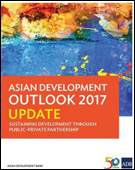 Asian Development Outlook (ADO) 2017 Update: Sustaining Development through Public-Private PartnershipDeveloping Asia is forecast to expand by 5.9% in 2017 and 5.8% in 2018, a slight upgrade from projections in the Asian Development Outlook 2017. However, growth forecast for South Asia is downgraded to 6.7% in 2017. India’s growth remains strong and most South Asian countries are expected to meet or exceed growth forecasts from April. Exceptions are Sri Lanka, where agriculture was affected by drought and floods, and Bhutan, where geological problems have constrained construction on two large hydropower projects. Growth in Nepal surged in 2017 on earthquake recovery but is slowing as agriculture struggles, following severe flooding in August 2017. Inflation forecast in South Asia is lowered to 4.2% for 2017 and 4.7% for 2018. Favorable global commodity prices, good harvests, and prudent macroeconomics are expected. Author: Asian Development Bank Year: 2017 Download Tags: Asia, Development, Sustainability, Public Private Partnerships, South Asia, India, Sri Lanka, Agriculture, Bhutan, Hydropower, Energy, Nepal The Internet of Things in the Power Sector: Opportunities in Asia and the PacificAsia’s power sector struggles to upgrade power systems and keep up with growing demand. The Internet of Things (IoT) has the potential to transform the power sector by optimizing operations and lowering costs for consumers. The power sector is already reaping the benefits of adoption of smart meters and smart thermostats, two consumer-oriented IoT applications. The Asian Development Bank has committed to smart grid projects in India, through a Green Energy Corridor and Grid Strengthening Project, and Maldives, through the Preparing Outer Islands for Sustainable Energy Development (Phase 1). Author: Arun Ramamurthy and Pramod Jain Year: 2017 Download Tags: Energy, ADB, India, Maldives, Sustainability 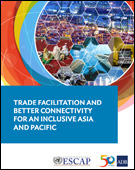 Trade Facilitation and Better Connectivity for an Inclusive Asia and PacificThis report investigates the evolution of trade costs, examines trade facilitation and paperless trade implementation, and highlights key initiatives in South Asia, including efforts by members of the South Asia Subregional Economic Cooperation (SASEC). The SASEC Trade Facilitation and Transport Working Group agreed to expand assistance to trade facilitation through technical assistance to support more efficient, transparent, secure, and service-oriented processing of cross-border trade across South Asia. Through 2025, the SASEC connectivity agenda will be better aligned with the frameworks of South Asian Association for Regional Cooperation and the Bengal Initiative for Multi-Sectoral Technical and Economic Cooperation. To help establish a trade and transport facilitation monitoring mechanism, Bangladesh, Bhutan, and Nepal conducted studies that reviewed trade and transport procedures, analyzed bottlenecks, and gave recommendations on trade and transport facilitation. Author: Asian Development Bank and United Nations Economic and Social Commission for Asia and the Pacific Year: 2017 Download Tags: ADB, Bangladesh, Bhutan, BIMSTEC, Maldives, Nepal, SAARC, India, Myanmar, SASEC, South Asia, Sri Lanka, Trade Facilitation, Transport, UNESCAP, ADB RCI Myanmar’s Engagement in Regional Integration: Status and Way Forward (AWP No. 169)Myanmar strategic position connects Asia’s three big markets—Association of Southeast Asian Nations, China, and India. Since 2011, Myanmar has laid down economic reforms that are unlocking the country’s potential. This working paper discusses Myanmar’s participation in regional partnerships, such as the South Asia Subregional Economic Cooperation, which it joined in 2017. It argues that such partnerships are essential in building Myanmar’s infrastructure and speeding up its growth. Author: Prabir De Year: 2017 Download Tags: ADB, ASEAN, India, Myanmar, Regional Cooperation, Regional Integration, SASEC, UNESCAP Together We Deliver: 50 Stories of ADB's Partnerships in Asia and the PacificThis special edition of Together We Deliver tells 50 stories that highlight the importance of good partnerships in Asia and the Pacific in meeting complex development challenges. In South Asia, ADB has supported infrastructure development and social programs, helping lift people out of poverty in a diverse, rapidly urbanizing subregion. The South Asia Subregional Economic Cooperation Roads Improvement Project, for instance, is set to widen 160 kilometers of Nepal’s East–West Highway, which connects Nepal to India. The improved roads will provide faster and better access to social services and economic opportunities, and will facilitate national and regional integration. Author: Asian Development Bank Year: 2017 Download Tags: ADB, Economic Corridor Development, India, Nepal, Regional Integration, Roads, SASEC, South Asia, Transport 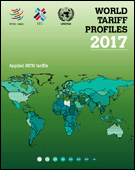 World Tariff Profiles 2017World Tariff Profiles is a joint publication of the World Trade Organization (WTO), International Trade Centre, and the United Nations Conference on Trade and Development devoted to information on market access for goods. It contains comprehensive data on tariffs and non-tariff measures imposed by over 170 countries and Customs territories. This year’s edition takes a close look at export diversification, analyzing to what extent economies have diversified their exports over time. Many countries make it a policy to diversify exports to obtain bigger market shares. An overview of export diversification shows how India, Myanmar, Sri Lanka, Bangladesh, and Bhutan have grown in the last two decades. Bangladesh in particular has achieved significant increase in terms of both product coverage and market reach. Author: World Trade Organization, International Trade Centre, and the United Nations Conference on Trade and Development Year: 2017 Download Tags: Bangladesh, Bhutan, Export, India, Maldives, Myanmar, Nepal, Sri Lanka, Tariffs, Trade, UNCTAD, WTO 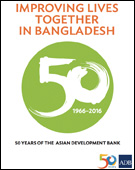 Improving Lives Together in Bangladesh: 50 Years of the Asian Development BankThis report highlights the milestones in the Bangladesh-Asian Development Bank (ADB) partnership since 1973, including projects in transport and energy that have shown sustained development results. Development contributions from ADB-assisted projects in Bangladesh include the Second South Asia Subregional Economic Cooperation Program (SASEC) Bangladesh-India Electrical Grid Interconnection Project that will help double electricity imports from India from the current 500 megawatts; the $505 million SASEC Railway Connectivity, Akhaura Laksam Double-Track Project, which will help railways meet passenger and freight demand; the SASEC Road Connectivity Project, which is upgrading a 70 km stretch along a corridor connecting the northwest to Dhaka to support domestic and subregional trade; and the SASEC Trade Facilitation Program, which aims to reduce non-tariff barriers by adopting international Customs administration protocols, upgrade existing Customs management systems, and establish a web-based electronic trade portal. Author: Asian Development Bank Year: 2017 Download Tags: SASEC, ADB, Bangladesh, India, Railway, Energy, Transport SARSO News: Vol. 31, No. 2The South Asian Regional Standards Organization (SARSO) newsletter features updates on SARSO events and activities. This issue features the publication of three South Asian Association for Regional Cooperation standards on food quality and safety, and the workshop on the importance of ISO 14001—which aims to help organizations improve environmental performance through the efficient use of resources and reduction of waste—and its impact on the environment and trade. It also has reports on Workshop on Conformity Standards held in New Delhi, India, and the Enhancing Capacity for Sanitary and Phytosanitary (SPS) Measures for Safe Trade in Animal and Animal Products in South Asia held in Kathmandu, Nepal. Author: South Asian Regional Standards Organization Year: 2017 Download Tags: Agriculture, Bangladesh, Bhutan, India, Nepal, SAARC, SARSO, South Asia, Standardization, Trade Asian Development Outlook (ADO) 2017 Supplement: Cautious Optimism for Asia's OutlookWith export demand stronger than expected in the first quarter of 2017, Asia’s GDP is expected to expand faster than forecast in April in Asian Development Outlook 2017. Developing Asia is now expected to grow by 5.9% in 2017. The smaller upgrade in the 2018 growth forecast—5.7% in ADO 2017 to 5.8%—reflects a cautious view on the pace of the turnaround in external demand. Excluding the newly industrialized economies, growth projections for the region are revised up to 6.4% for 2017 and to 6.3% for 2018. India is expected to achieve April forecasts of 7.4% growth in 2017 and 7.6% in 2018, primarily from strong consumption. Growth projections for South Asia are likewise maintained as prospects remain robust. Author: Asian Development Bank Year: 2017 Download Tags: ADB, Development, Export, Bangladesh, India, South Asia World Trade Statistical Review 2017The World Trade Statistical Review looks at the last 10 years and examines the latest developments in world trade, with a detailed analysis of the most recent trends for trade in goods and services. The book gives information on the participation of India, Bangladesh, and other South Asian economies in world trade, and highlights trends in the use of trade-facilitating measures. It also gives information on the implementation of the WTO Trade Facilitation Agreement and regional trade agreements, such as the South Asian Free Trade Arrangement. Author: World Trade Organization Year: 2017 Download Tags: Export, Least Developed Countries, Aid for Trade, SAFTA, South Asia, Trade Facilitation, WTO, Bangladesh, Bhutan, India, Maldives, Myanmar, Nepal, Sri Lanka Win-Win: How International Trade Can Help Meet the Sustainable Development GoalsThis book aims to demonstrate to policy makers how international trade can contribute to achieving the Sustainable Development Goals (SDGs). Trade can promote income growth, which can then support sustainable development. In addition, there are also direct links between trade and sustainable development, such as trade’s effect on the price and availability of health, education, energy, and other important services. This book maps out a triple-win scenario where good trade policy spurs international trade, contributes to development-friendly outcomes, and helps achieve the SDGs. Author: Matthias Helble and Ben Shepherd, eds. Year: 2017 Download Tags: Bangladesh, India, Maldives, Nepal, Services, South Asia, Sustainability, Sustainable Development Goals Lessons from ADB Transport Projects: Moving Goods, Connecting People, and Disseminating KnowledgeThis publication shares 20 case stories from the Asian Development Bank bearing practical lessons for transport projects across Asia and the Pacific region under different socioeconomic and political situations. The book includes reports on improving aviation in Bhutan, working on computerized transport and trade logistics in Nepal, and constructing Sri Lanka's Greenfield Highway, and the role policy plays in those projects. It also draws lessons from how India's road development increased rural communities' access to public services and economic opportunities, and how participatory processes in selecting road improvement projects in Bangladesh provide a model for long-term plan for road maintenance. Author: Asian Development Bank Year: 2017 Download Tags: ADB, Bangladesh, Bhutan, India, Nepal, Railway, Sri Lanka, Transport, ADB RCI Digital Trade Facilitation: Paperless Trade in Regional Trade AgreementsMost regional trade agreements now feature one or more measures for electronically exchanging trade-related information. These measures are becoming essential to maintaining trade competitiveness and enabling effective participation in cross-border e-commerce. This paper examines the extent to which measures enabling paperless trade are included in regional trade agreements (RTAs), such as the Association of Southeast Asian Nations-India Free Trade Agreement. India leads the region with the highest number of RTAs involving paperless trade measures. Asia-Pacific RTAs now increasingly cover specific areas of paperless trade such as electronic certificates of origin and sanitary and phytosanitary certificates. Author: Yann Duval and Kong Mengjing Year: 2017 Download Tags: ADB, ASEAN, Free Trade Agreements, India, Regional Cooperation, Trade Facilitation, UNESCAP, WTO World Investment Report 2017This report presents foreign direct investment (FDI) trends and prospects at global, regional and national levels. FDI flows to developing Asia contracted by 15% to $443 billion in 2016. This decline was relatively widespread, except in South Asia, where several countries including Bangladesh and Nepal are expected to receive more FDI in the coming years. The report investigates the internationalization patterns of digital multinational enterprises, as well as the effect of digitalization on global companies across all industries. It provides insights to policymakers on how the digital economy impacts investment policies and how investment policy can support digital development, with a view toward achieving the SDGs. Author: United Nations Conference on Trade and Development Year: 2017 Download Tags: FDI, Global Value Chains, Investment, Policy, South Asia, UNCTAD, Bangladesh, India, Nepal Regional Cooperation for Sustainable Energy in Asia and the PacificCountries in the Asia-Pacific region face multiple energy-related challenges, which are driving transformation of energy systems. Addressing these energy challenges is an integral part of implementing the 2030 Agenda for Sustainable Development, including ensuring access to affordable, reliable, sustainable, and modern energy for all. This report analyzes challenges in the Asia-Pacific region and its efforts to accelerate the energy transition to achieve Sustainable Development Goal 7. Author: United Nations Economic and Social Commission for Asia and the Pacific Year: 2017 Download Tags: Asia-Pacific, Energy, Sustainability, Sustainable Development Goals, UNESCAP, Bangladesh, Bhutan, India, Maldives, Myanmar, Nepal, Sri Lanka 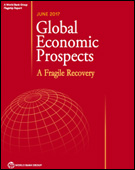 June 2017 Global Economic Prospects: A Fragile RecoveryThe World Bank forecasts that global growth will strengthen to 2.7% in 2017 amid a pickup in manufacturing and trade, rising confidence, favorable global financing conditions, and stabilizing commodity prices. In South Asia, growth is projected to remain strong at 6.8% in 2017. India is recovering from the temporary adverse effects of the end-2016 withdrawal of large-denomination currency notes. Activity in Bangladesh is moderating, reflecting a pullback in domestic demand and industrial production. Regional growth is expected to steady in 2018-2019, reaching an average of 7.2%, supported by strong domestic demand, a small rise in exports, and strong foreign direct investment. The regional outlook has been slightly revised down from January, reflecting a more protracted recovery in private investment in India than previously expected. Author: World Bank Group Year: 2017 Download Tags: WB, Bangladesh, FDI, India, Manufacturing, South Asia, Trade Eradicating Poverty and Promoting Prosperity in a Changing Asia-PacificThis report explores five long-term trends in the Asia-Pacific region that will shape approaches to poverty alleviation and the prospects for achieving prosperity: regional economic cooperation and integration; rural–urban transitions; demographic changes; ICT access and connectivity; and demand for natural resources. It examines the changing development context in South Asian and other economies. It also looks at opportunities created by regional cooperation and integration that intend to bring about shared economic benefits. Author: United Nations Economic and Social Commission for Asia and the Pacific, Asian Development Bank, United Nations Development Programme Year: 2017 Download Tags: ADB, Connectivity, ICT, Regional Cooperation, Sustainability, UNESCAP, UNDP, Bangladesh, Bhutan, India, Maldives, Nepal, Sri Lanka 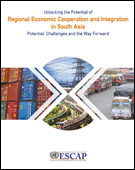 Unlocking the Potential of Regional Economic Cooperation and Integration in South AsiaAt a modest 6% of total trade, intraregional trade in South Asia stands at less than one third of its full potential. Trade barriers and inadequate infrastructure have cost South Asia over US $54 billion per year in lost export opportunities. With 309 million people living on less than $1.90 a day—the largest concentration of poverty in the world—South Asia should urgently pursue broad-based regional economic cooperation that could enable effective responses to the subregion’s developmental challenges. This report examines the state of economic integration in South Asia and identifies potential areas for further strengthening subregional linkages. It provides recommendations on policy actions to increase market integration, improve connectivity, boost investment in infrastructure development, and tackle shared vulnerabilities and risks. It calls for the consolidation and upgrading of existing trade and investment cooperation initiatives into a South Asia Comprehensive Economic Partnership. Author: United Nations Economic and Social Commission for Asia and the Pacific Year: 2017 Download Tags: BIMSTEC, Investment, Regional Cooperation, SAARC, South Asia, Sustainability, Sustainable Development, Trade, UNESCAP, Bangladesh, Bhutan, India, Maldives, Myanmar, Nepal, Sri Lanka Can Online Markets Make Trade More Inclusive? Technology-driven online trade reduces income inequality and makes trade more inclusive. To fully realize these new gains from trade, governments and export promotion agencies should address barriers to e-commerce. Technology made available by online markets has significantly reduced the cost of entry into international markets for small and medium-sized firms, which can now reach more distant consumers and create a global reputation as a seller at very low costs. Online firms, even those smaller than traditional offline firms, export, and this paper shows that online markets help reduce income inequality by providing smaller firms access to international markets. Author: Andreas Lendle and Marcelo Olarreaga Year: 2017 Download Tags: ADB, ICT, India, Trade 2016 Development Effectiveness ReviewThe Development Effectiveness Review tracks development progress in Asia and the Pacific and monitors the Asian Development Bank’s (ADB) effectiveness 2010-2016. For South Asia, ADB shares results in regional cooperation, energy, and road and rail transport. ADB also approved $4.4 billion in financing for projects in South Asia during 2016. The Review includes details of ongoing and newly approved projects. Author: Asian Development Bank Year: 2017 Download Tags: ADB, Asia-Pacific, Development, Poverty Reduction, Regional Cooperation, Regional Integration, Roads, Transport, Bangladesh, Bhutan, India, Maldives, Nepal, Sri Lanka The Little Data Book on Information and Communication TechnologyThis book presents quick indicators for more than 200 countries showing data on key indicators of information and communications technology (ICT), including access, quality, affordability, efficiency, sustainability, and applications. It includes data for Bangladesh, Bhutan, India, Maldives, Myanmar, Nepal, and Sri Lanka. Author: World Bank and International Telecommunications Union Year: 2017 Download Tags: Bangladesh, Bhutan, ICT, India, Maldives, Myanmar, Nepal, Sri Lanka, South Asia, WB Basic Statistics 2017Basic Statistics 2017 contains development indicators for 45 economies in the Asia and Pacific Region, including the seven SASEC countries, Bangladesh, Bhutan, India, Maldives, Myanmar, Nepal, and Sri Lanka. It includes selected indicators of the Sustainable Development Goals (SDGs) such as the proportion of population living below $1.90 (PPP) a day, proportion of population with access to electricity, renewable energy share in the total final energy consumption, unemployment rate, total official flows for infrastructure, and trade balance. Author: Asian Development Bank Year: 2017 Download Tags: Energy, Trade Facilitation, Transport, Sustainable Development Goals, Bangladesh, Bhutan, India, Maldives, Myanmar, Nepal, Sri Lanka 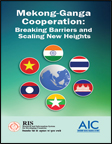 Mekong-Ganga Cooperation: Breaking Barriers and Scaling New HeightsThe Mekong-Ganga Cooperation (MGC) promotes intra-regional collaboration among Cambodia, India, Lao PDR, Myanmar, Thailand and Vietnam in the areas of trade, tourism, culture, education, and transport and communications. This book reviews how MGC cooperation has grown since MGC's inception in 2000, including expansion of their economic and cultural relations. Under India's Act East Policy, MGC has gained further momentum – endorsing a Plan of Action 2016-2018, and planning extended connectivity of the India-Myanmar-Thailand Trilateral Highway to Cambodia, Laos, and Vietnam. This report outlines important discussion points on trade, regional value chains, foreign direct investment, physical and digital connectivity, border connectivity, and cultural relations, to strengthen India and the Association of Southeast Asian Nation linkages through MGC. Author: Research and Information System for Developing Countries and ASEAN-India Centre Year: 2017 Download Tags: ASEAN, India, Southeast Asia, South Asia, Trade, Trade Facilitation Global Energy InterconnectionSustainable energy and climate change are major global concerns, yet three billion people around the world rely on wood, coal, or animal waste for cooking and heating. The interconnection of grids would open up opportunities for resource sharing and bring clean energy to much more of the world. This paper assesses benefits and outlines policy, technical, and economic preconditions for global energy interconnection. It analyzes global transmission scenarios and evaluates their impact on energy supplies and the environment. It also gives recommendations for setting standards, and where stakeholder involvement is necessary. Author: International Electrotechnical Commission Year: 2017 Download Tags: Energy, India, Nepal, Policy, Standardization, Sustainability, Trade, South Asia Implications of Brexit to the Asia-Pacific Region: with a Focus on Least Developed Countries (Trade Insights: Issue No. 20)This issue of Trade Insights, published by United Nations Economic and Social Commission for Asia and the Pacific, discusses how possible Brexit scenarios could adversely affect least developed countries in the Asia-Pacific region. Simulation results show that potential reduction in exports to the United Kingdom for fish, clothes, textiles, footwear, and other key items can range from 16% to 50% of their current export value. According to the study, countries heavily exposed to Brexit-induced risks must analyze the extent of such impact and engage the United Kingdom in discussions in order to limit negative impact. Author: Louis Graham, Arun Jacob, and Anders K. Møller Year: 2017 Download Tags: Asia-Pacific, Least Developed Countries, South Asia, Trade, UNESCAP, India, Bangladesh, Maldives, Myanmar, Nepal, Sri Lanka Asian Development Outlook 2017: Transcending the Middle-Income Challenge The Asian Development Outlook 2017 forecasts 5.7% growth for developing Asia in 2017 and 2018, and 7% and 7.2% for South Asia in 2017 and 2018. Resumption of growth in South Asia follows the brief slowdown in 2016 due to decline in fixed investment and impact of demonitization on trade and commerce. Growth in India is forecast at 7.4% in fiscal 2017 and 7.6% in 2018. In Bhutan, growth is expected to accelerate to 8.2% in 2017, with expanded investment in hydropower for export, and added capacity in electricity generation. Nepal's growth is expected to revive to 5.6% in 2017 with increased post-earthquake reconstruction and more reliable electricity. Author: Asian Development Bank Year: 2017 Download Tags: ADB, India, Bhutan, Nepal, South Asia 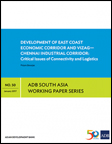 Development of East Coast Economic Corridor and Vizag-Chennai Industrial CorridorThe East Coast Economic Corridor (ECEC)—India’s first coastal corridor—is an integrated economic development initiative that is expected to help pursue industrialization and integrate domestic companies into the global value chains of Southeast Asia and East Asia. Its development will start with Vizag–Chennai Industrial Corridor (VCIC), which covers about 800 kilometers and includes several ports and major industrial centers. This paper discusses strategies to consider when trying to improve shipping and air connectivity in the ECEC and Vizag–Chennai Industrial Corridor (VCIC). It stresses the importance of infrastructure development and regulatory reforms that facilitate increased connectivity. Author: Pritam Banerjee Year: 2017 Download Tags: Bangladesh, Connectivity, Economic Corridor, India, Infrastructure, Regional Integration, Trade Facilitation, Transport, Development, Economic Corridor Development, ADB RCI 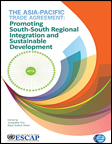 The Asia-Pacific Trade Agreement: Promoting South-South Regional Integration and Sustainable DevelopmentAs countries begin to depend on more each other, trade policy is helping achieve inclusive and sustainable development. Trade and investment are linked to the environment and social issues, and countries now realize that cooperation is necessary in approaching global and regional problems. The Asia-Pacific Trade Agreement (APTA), the oldest preferential trade agreement in the region, helps promote economic development and the adoption of mutually beneficial trade measures. This book gives an overview of the APTA and outlines potential benefits and challenges for members new to the APTA. The book details a possible road map for APTA and suggests that APTA move from the conventional preferential agreement to a comprehensive economic integration agreement by converting to FTAs in goods, services, investment, trade facilitation and non-tariff measures. Author: Joong-Wan Cho and Rajan Sudesh Ratna (editors) Year: 2017 Download Tags: Asia-Pacific Trade Agreement, Bangladesh, India, Sri Lanka, Regional Integration, Sustainability, UNESCAP Renewable Energy Sector in Emerging Asia: Development and Policies (TIID Working Paper No. 1/2017)Rapid economic growth in emerging Asia has led to a critical increase of greenhouse gas emissions. Transitioning to renewable energy sources would help reduce emissions. However, massive investment is needed to make that transition. According to this paper, targeted policy interventions are needed to facilitate trade and investment in the renewable energy sector and create “green jobs” in the low-carbon and resource-efficient sectors. Author: Masato Abe, Candice Lea Marie Branchoux, Jaewon Kim Year: 2017 Download Tags: Bangladesh, Energy, Governance, Hydropower, Employment, India, Myanmar, Sustainability, UNESCAP 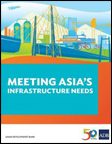 Meeting Asia's Infrastructure NeedsThis report estimates infrastructure investment needs in Asia and the Pacific for 2016-2030, updating the Asian Development Bank's assessment for 2010-2020 published in 2009. The report places developing Asia's investment needs at $26 trillion to maintain its growth momentum, eradicate poverty, and respond to climate change. While developing Asia's infrastructure, including its transport network and electricity generation capacity, has improved significantly over the years, it remains far from adequate – lack of reliable power supply continues to constrain economic growth and traffic congestion results in lost productivity, wasted fuel, and human stress. The report recommends $14.7 trillion investment for power and $8.4 trillion for transport. South Asia requires investments valued at 8.8% of gross domestic product. Author: Asian Development Bank Year: 2017 Download Tags: Asia, South Asia, Energy, Transport, Bangladesh, Bhutan, ADB, India, Maldives, Myanmar, Sri Lanka, Nepal 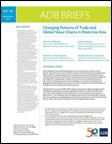 Changing Patterns of Trade and Global Value Chains in Postcrisis AsiaThis Asian Development Bank brief examines how patterns of trade and global value chains (GVCs) in developing Asia have changed since the global financial crisis. The paper reports that export slowdown in the region was caused by a combination of weak import demand for Asian goods in advanced economy markets, structural transformation and reduced import demand in the People’s Republic of China, and possible impact of increasing non-tariff measures. According to this paper, it further states that much of the weak import demand is likely
to be temporary — developing Asia gained a 1.5% increase in exports in 2016, after a 0.8% decline in 2015. Among South Asian economies, India and Sri Lanka are expected to have better export volume growth in 2016. Author: Ganeshan Wignaraja, Juzhong Zhuang, Mahinthan J. Mariasingham, and Madeline Dumaua-Cabauatan Year: 2017 Download Tags: Global Value Chains, Import, Export, India, Sri Lanka, Non-Tariff Measures, Trade Facilitation South Asia’s Turn: Policies to Boost Competitiveness and Create the Next Export PowerhouseWill South Asia become the next global factory? By 2030 more than a quarter of the world’s working adults will live in South Asia. As the work force ages and labor costs rise in China and other East Asian countries, many eyes turn to South Asia. According to this report, to realize the region’s potential, countries in South Asia should increase regional and global integration, take advantage of agglomeration economies, strengthen firm capabilities, and improve the business environment. Author: Gladys Lopez‐Acevedo, Denis Medvedev, and Vincent Palmade Year: 2017 Download Tags: Bangladesh, India, Regional Integration, South Asia, Trade, WB Paperless Trade in Regional Trade AgreementsThis working paper provides a comprehensive list of paperless trade measures in regional trade agreements, which have become more extensive, covering increasingly specific areas including certificate of origins and sanitary and phytosanitary certificates. It also confirms that the number of paperless trade measures have doubled between 2005-2008 and 2013-2016 at the global level, with regional trade containing more provisions than those featured in the World Trade Organization's Trade Facilitation Agreement. It introduces the new United Nations Treaty and Framework Agreement on Cross-Border Paperless Trade in Asia and the Pacific, which aims to become a tool for harmonized implementation of paperless trade provisions. Author: Yann Duval and Kong Mengjing Year: 2016 Download Tags: Paperless Trade, Sanitary and Phytosanitary Measures, Trade Facilitation, India 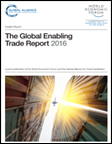 Global Enabling Trade Report 2016The Global Enabling Trade Report has been created to provide insight into trade policy and practice. It includes the Enabling Trade Index (ETI), which assesses the extent to which economies have in place institutions, policies, infrastructures and services facilitating the free flow of goods over borders and to their destination. This edition highlights that while an increasingly globalized trading system has been lifting millions out of poverty, trade barriers and costs are still preventing millions of people around the world from engaging in international trade. It reports that all South Asian economies have improved their ETI score over the past two years, with Bhutan as the most improved country in the region, jumping 12 places to 92, followed by India at 102, Sri Lanka at 103, Nepal at 108, Pakistan at 122, and Bangladesh at 123, yet the region remains the most closed worldwide. While South Asia has improved its access to foreign markets and adoption of ICTs, it needs to improve access to its domestic market – on average, South Asian countries impose a tariff of 16.7% on imported products – and enhance its transport infrastructure, particularly in Bhutan and Nepal. Author: Global Alliance for Trade Facilitation and the World Economic Forum Year: 2016 Download Tags: Trade, Trade Facilitation, Transport, Trade Policy, World Economic Forum, Bangladesh, Bhutan, India, Sri Lanka, Pakistan 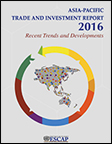 Asia-Pacific Trade and Investment Report 2016: Recent Trends and DevelopmentsThe Asia-Pacific Trade and Investment Report 2016 reports that the Asia-Pacific region is still the largest exporter of goods globally, with a share of 40%. Its share in commercial services trade is also on the rise, while restrictiveness of services trade has not increased. Foreign direct investment (FDI) inflows is also growing at a much faster pace compared to the global average, with special economic zones being used as one of the modalities to attract FDI. India, in particular, has been attracting an increasing portion of FDI inflows, both from outside and inside the region. While economies in Asia and the Pacific continue to make progress toward trade facilitation, there are still huge gaps among subregional economies, with much needing to be done to reduce trade costs. Furthermore, efforts undertaken to reduce trade costs through trade facilitation have been partially offset by imposition of a large number of new trade distortive measures globally and regionally, with most of these new measures falling under the non-tariff category. Author: United Nations Economic and Social Commission for Asia and the Pacific Year: 2016 Download Tags: Export, Trade Facilitation, Non-Tariff Measures, FDI, South Asia, India, Special Economic Zones Economic Benefits from Nepal-India Electricity TradeThis report confirms Nepal and India's viable electricity export potential, and highlights how facilitating cross-border trade of electricity will benefit both countries. In Nepal, substantial economic gains can boost the economy and improve the well-being of its people—in 2045 under the accelerated power trade scenario, electricity trade revenue can bring in up to $9.8 billion. In India, gains from cross-border trade centers on lower electricity system cost—hydropower imports from Nepal will allow India to forgo some investment needed to meet its capacity demand. Furthermore, hydropower will complement India's solar and wind power generation, offering an affordable and convenient renewable resource to meet its evening peak demand. Author: South Asia Regional Initiative for Energy Integration Year: 2016 Download Tags: Energy, Trade, India, Nepal, Hydropower 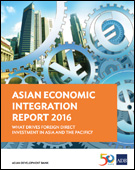 Asian Economic Integration Report 2016: What Drives Foreign Direct Investment in Asia and the Pacific?The 2016 Asian Economic Integration Report reviews regional economic cooperation and integration in Asia and the Pacific, amidst the rising global uncertainty following the United Kingdom’s referendum on leaving the European Union and the U.S. election, slower-than-expected global economic recovery, and ongoing economic restructuring in the People’s Republic of China and growth moderation. Asia faces heightened uncertainty–trade growth decelerated in 2015, falling to 2.3% in 2015; subregional trade linkages continue to strengthen, but inter-subregional trade linkages weakened; and non-tariff measures have become major obstacles to trade. In South Asia, SASEC cooperation has improved access to key markets in smaller economies, reduced real trade costs and behind-the-border barriers to stimulate investment; and enabled cross-border power exchanges to ensure power supply affordability, reliability, and overall grid stability. However, the SASEC agenda needs to be framed within wider integration processes taking place in Asia in the next decade to enhance economic linkages, and harness the full potential of Asian integration. Author: Asian Development Bank Year: 2016 Download Tags: ADB, ASEAN, Asia-Pacific, Development, FDI, Free Trade Agreements, Regional Cooperation, Regional Integration, SASEC, Trade Facilitation, UNCTAD, Bangladesh, Bhutan, India, Maldives, Nepal, Sri Lanka SME Competitiveness Outlook: Meeting the Standard for TradeStandards and regulations for goods and services are important to international trade and value chains. They ensure consumer protection, determine compatibility, and promote environmental sustainability. This SME Competitiveness Outlook focuses on helping small and medium-sized enterprises (SME) make the most of standards and regulations to increase their competitiveness. Findings include strategies for SME managers on selecting and implementing standards and regulations, and an action plan for policymakers and trade and investment support institutions involved in aiding SMEs compete in markets where standards and regulations matter. Author: International Trade Centre Year: 2016 Download Tags: Trade, Small and Medium Enterprises, Bangladesh, India, Nepal, Sri Lanka, WTO, Global Value Chains South Asia Economic Focus, Fall 2016: Investment Reality CheckSouth Asia continues on a path of gradual acceleration in 2016, led by a solid India. However, amid the resilience to external headwinds, including China’s slowdown and uncertainty surrounding monetary policy in advanced economies, South Asia is starting to feel the effect of slowing remittance flows or waning oil price dividends. Against this backdrop, this World Bank publication forecasts growth for the region at 7.1% in 2016, with its medium-term performance strongly dependent on investment and export turnout. India is set to grow at 7.6% in 2016, with the same speed as in 2015, but may increase its pace again in 2017 to 7.7%. The report highlights how private investment is a key future growth driver across South Asia that could help further boost the pace of economic activity. Author: World Bank Year: 2016 Download Tags: India, South Asia, Investment, Economic Growth, WB, Export Asia-Europe Connectivity Vision 2025: Challenges and OpportunitiesThe 11th Asia-Europe Meeting (ASEM) Summit held in Mongolia in 2016 saw ASEM member countries renew their commitments for deepened engagement between Asia and Europe. This report on the Summit provides ideas for an ASEM roadmap for connectivity, recognizing the need for sustainability and scalability. The report draws lessons from efforts by the Association of Southeast Asian Nations to bring together peoples, goods, services, and capital. ASEM, an intergovernmental forum for dialogue and cooperation, comprises 53 member countries, including India and Bangladesh. Author: Anita Prakash, editor Year: 2016 Download Tags: ASEAN, India, Bangladesh, Connectivity South Asian Approach to Sustainable Development Goals: Trade Insight Vol. 12, No. 1, 2016The paper, published by South Asia Watch on Trade, Economics and Environment, situates the challenges of implementation of the Sustainable Development Goals (SDGs) in the South Asian context. Noting that the delivery of the Millennium Development Goals in the region had been quite uneven, the paper examines the potential for regional cooperation to better achieve the SDGs. The paper then tries to chart a South Asian pathway for SDGs implementation and put forward some concrete proposals for South Asian countries. Author: Debapriya Bhattacharya and Umme Shefa Rezbana Year: 2016 Download Tags: ASEAN, India, Economic Integration Celebrating the Third Decade and Beyond: New Challenges to ASEAN-India Economic PartnershipThe relationship between ASEAN and India is set to deepen as ASEAN and India step up their collaboration across a range of economic and strategic issues, including trade and connectivity, culture, people-to-people links, trans-national terrorism, and maritime security. This book seeks to review the past and suggest ways to further strengthen economic partnership between ASEAN countries and India. It primarily deals with the economic integration issues between ASEAN and India, and assesses policy priorities, effectiveness, implementation imperatives and challenges. The book tries to capture essential features of cross-cutting issues and attempts to draw policy implications. Author: KW Publishers Year: 2016 Download Tags: ASEAN, India, Connectivity 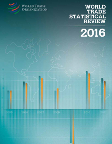 World Trade Statistical Review 2016The World Trade Statistical Review is the World Trade Organization's latest flagship publication offering a detailed analysis of the latest developments on global trade in goods and services—including developments in trade policy and participation of developing economies and least developed countries—examined through analytical chapters, complemented by over 50 tables. The publication reports that in 2015, developing Asia represented 67% of developing economies’ exports. In merchandise trade, India ranked 9th among the world's top exporter of agricultural products, and continues to be one of the top 3 textile exporters, which accounts for nearly 2/3s of world exports. A 25% decline in LDC exports was reported, due to the negative impact of the drop in fuel prices and mining products. LDC participation in global exports of commercial services also remained negligible at 0.8%. In trade policy making, the publication reported that WTO members introduced 132 measures to facilitate trade, yet applied 154 new trade-restrictive measures during the period between mid-October 2015 and mid-May 2016. Author: World Trade Organization Year: 2016 Download Tags: Trade, Export, India, Least Developed Countries  Summary of Proceedings of the 49th Annual Meeting of the Board of GovernorsThis publication provides a summary of the proceedings of the 49th Annual Meeting of the Asian Development Bank (ADB) Board of Governors, held in Frankfurt, Germany from 2-5 May 2016. It also includes statements from the Governors of ADB member countries, including SASEC countries. In his address, Mr. Abul Maal Muhith, Governor, Bangladesh, called for further acceleration of ADB's regional cooperation and integration strategy, which could play a critical role in accelerating economic growth, reducing poverty and economic disparity, and raising productivity and employment and environmental sustainability in Bangladesh, and lauded ADB's support in the signing of the landmark Bangladesh-Bhutan-India-Nepal Motor Vehicle Agreement (BBIN MVA). Mr. Arun Jaitley, Governor, India, highlighted India's strong and renewed commitment to regional cooperation in South Asia, which was demonstrated with the signing of the BBIN MVA and ongoing negotiations for the India-Myanmar-Thailand Highway. He also emphasized partnership between ADB and India in the development of the East Coast Economic Corridor, with initial focus on the ‘Vizag Chennai Industrial Corridor’, which will play a major role in connecting India to global production networks and value chains in the ASEAN region. Author: Asian Development Bank Year: 2016 Download Tags: ADB, Bangladesh, India, Regional Cooperation, Poverty Reduction Cleantech Start-ups Can Solve Climate ChangeThe Asian Development Bank (ADB), through its Climate Technology Finance Center, seeks to accelerate clean technology entrepreneurship and investment in Asia by supporting programs that aim to produce investable clean technology, risk capital for clean technology, technological knowledge, and a stronger clean technology ecosystem. This brochure gives a brief background on how ADB works with start-ups across Asia to promote more efficient management of energy and natural resources. Author: Asian Development Bank Year: 2016 Download Tags: ICT, Energy, Environment, India ASEAN-India Air Connectivity ReportAir connectivity plays an important component in India’s connectivity agenda with the Association of Southeast Asian Nations (ASEAN). This ASEAN-India Air Connectivity Report addresses issues and challenges concerning air connectivity between India and ASEAN, including constraints and bottlenecks hindering growth of air cargo that would help unlock trade potential. With India embarking on “Make in India” and “Skill India” policies, stronger air connectivity has become all the more important in the context of India’s drive for economic integration with its neighbors in the east. Author: ASEAN-India Centre and Research and Information Centre for Developing Countries Year: 2016 Download Tags: Transport, ASEAN, India, Manufacturing Facilitating Trade between India and Sri LankaIndia and Sri Lanka have duty-free access to each other’s markets through the India-Sri Lanka Free Trade Agreement. Yet in recent years, traders from both countries have rarely utilized the agreement. This study aims to identify ways to improve importing and exporting under the agreement. It examines key issues and how to address them through the education of traders and Customs officials on goods eligible for concessions, facilitating testing and certification, streamlining Customs procedures, and establishing help desks. The study also offers recommendations in the areas of trade facilitation that may be incorporated in future negotiated agreements. Author: Suwendrani Jayaratne and Janaka Wijayasiri Year: 2016 Download Tags: Sri Lanka, India, Exports, Trade, Customs  Hydropower @ CrossroadsIndia has significant hydropower potential and can meet a demand of around 85 gigawatts, at 60% load factor. Increasing the country’s hydropower capacity could reduce generation costs and benefit both communities and industry. Hydropower also has the advantage of contributing very little to carbon emissions. However, only 41 gigawatts of hydropower capacity has been installed, accounting for only 28% of the total potential. Hydropower can play a crucial role in India’s sustainable development and energy needs given that it meets the criteria of sustainability, availability, reliability, and affordability. This publication provides recommendations that could be of use to policymakers and other interested parties. The book lays out the status of hydroelectric power in India and analyzes opportunities to increasing capacity. It provides recommendations with regard to market development, safeguard issues, financing, land acquisition, technical challenges, hydropower planning, and enabling infrastructure. Author: The Associated Chambers of Commerce of India and PricewaterhouseCoopers Year: 2016 Download Tags: Hydropower, Energy, India 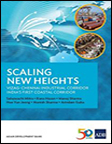 Scaling New Heights: Vizag-Chennai Industrial Corridor, India’s First Coastal CorridorThis book provides policymakers with a guide to understanding India’s economic corridor development strategy by examining its first coastal economic corridor, the East Coast Economic Corridor. It lays out the plan for its first phase, the Vizag–Chennai Industrial Corridor, which can help unify the country's domestic market, integrate its economy with Asia's global value chains, and support the 'Make in India' initiative to spur manufacturing through construction of world-class infrastructure supported by a major transport network, connecting urban clusters complemented by vibrant industrial zones, and encouraging a favorable and competitive environment for businesses to thrive, and facilitating efficient movement of goods and people. As a policy instrument and development strategy, economic corridors can help fast-track inclusive and sustainable economic growth, stimulate rapid industrialization and increase productivity, promote investments, and expand regional connectivity. Author: Sabyasachi Mitra, Rana Hasan, Manoj Sharma, Hoe Yun Jeong, Manish Sharma, and Arindam Guha Year: 2016 Download Tags: Economic Corridor, India, Trade Facilitation, Transport, Employment, Economic Corridor Development, ADB RCI Asian Development Outlook 2016: Asia’s Potential GrowthThe Asian Development Outlook 2016 forecasts 5.7% growth for developing Asia in 2016 and 2017. It projects that South Asia will post the most rapid growth in developing Asia, with growth in the subregion accelerating to 7% in 2015, and will accelerate further to 7.3% in 2017 after a slight dip to 6.9% in 2016. India's growth is expected to undergo a slight slowdown to 7.4% in 2016 as exports decline and both public and private investment slows, but rebound to 7.8% in 2017 as the business environment improves, and exports and investment recover. Bangladesh will also see continued moderate growth, resulting from sustained progress toward macroeconomic and structural reform. Author: Asian Development Bank Year: 2016 Download Tags: Asia, India, Bangladesh, Economic Growth, Development, ADB 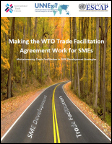 Making the WTO Trade Facilitation Agreement Work for SMEsSmall and Medium Enterprises (SMEs) comprise 95% of enterprises worldwide and provides at least two thirds of private sector employment. However, when it comes to international trade, SMEs experience limited capacity in dealing with the complex administrative and regulatory procedures associated with moving and selling goods across borders. This book fills a gap by providing a reference for articles of the World Trade Organization (WTO) Trade Facilitation Agreement (TFA) that are particularly beneficial to SMEs, and identifies examples of SME-specific programs, measures and interventions that can support the implementation of such provisions. It proposes mainstreaming relevant elements of the WTO TFA in existing SME policies and initiatives, to ensure that it contributes toward internationalization of SMEs.
Author: UNESCAP, UNNExT, and ITC Year: 2016 Download Tags: Small and Medium Enterprise, Trade Facilitation, Trade, UNESCAP, Small and Medium Enterprises, India, Nepal 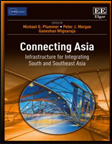 Connecting Asia: Infrastructure for Integrating South and Southeast AsiaThis book contains background papers prepared for the Asian Development Bank and the Asian Development Bank Institute joint study, 'Connecting South Asia and Southeast Asia.' It emphasizes the potential contribution to growth that greater connectivity—through better transport and energy infrastructure and improved soft infrastructure, including trade facilitation—between South Asia and Southeast Asia can foster. With benefits including greater participation in global supply chains for South Asia; lower trade costs; and increase in inter- and intraregional trade, the book underscores that, at a juncture where closer regional integration can secure sustainable and inclusive growth for economies in the two regions, specific policies should be examined and considered to enable both regions to maximize gains from greater integration. Author: Michael G. Plummer, Peter J. Morgan, Ganeshan Wignaraja, eds. Year: 2016 Download Tags: South Asia, Southeast Asia, Trade Facilitation, Transport, Energy, ADB, Economic Corridor, Bangladesh, India, Sri Lanka, ADB RCI 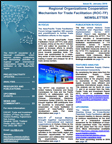 Regional Organizations Cooperation Mechanism for Trade Facilitation, Issue IX, January 2016This biannual publication features updates, publications and forthcoming activities of regional and international organizations working on trade facilitation in the Asia-Pacific region, including the Asian Development Bank (ADB), the World Customs Organization (WCO), and the United Nations Economic and Social Commission for Asia and the Pacific. It includes highlights of the Asia Pacific Trade Facilitation Forum 2015 and the Train-the-Trainer Workshops on Customs Valuation through Post Clearance Audit being jointly implemented by the WCO and ADB in the 6 SASEC member countries. This issue also features an analysis on achieving seamless supply chains through implementing comprehensive and pragmatic national trade facilitation reform programs. Author: UNESCAP Year: 2016 Download Tags: Trade Facilitation, Asia-Pacific, WCO, ADB, UNESCAP, Customs Valuation, Nepal, Bangladesh, Bhutan, India, Maldives, Sri Lanka World Energy Outlook 2015Global energy is undergoing major changes. Renewables are increasingly contributing to the the world’s power generation capacity, and coverage of mandatory energy efficiency regulation worldwide has expanded to more than a quarter of global consumption. This World Energy Outlook 2015 provides insights to policy-makers, industry and other stakeholders on the state of the energy sector today, discussing which changes are transient or cyclical, the risks and opportunities that may lie ahead, and actions that can put the energy system on a more secure and sustainable footing. It also includes a special chapter discussing India’s energy outlook, and how development in India's energy sector over the coming decades will impact the country and the global energy system as a whole. Author: International Energy Agency Year: 2015 Download Tags: Energy, India, Renewables 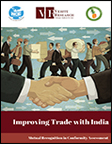 Improving Trade with India: Mutual Recognition in Conformity AssessmentThis study examines the current status of Sri Lankan exports to India, focusing on non-tariff barriers (NTBs) existing between India and Sri Lanka, including conformity assessment procedures applied in the two countries. Providing a comprehensive analysis of issues related to standards and regulations faced by processed food exporters from Sri Lanka to India, the study highlights how India's non-recognition of testing and certification conducted outside its borders forms a significant barrier, one that is critical to the performance of Sri Lanka's exports to India. It proposes that the most workable solution is to implement a Mutual Recognition Agreement, which will allow recognized, competent and accredited conforming assessment bodies from India and Sri Lanka to accept certificates of conformity, letting Sri Lankan exporters take advantage of duty concessions offered by the India-Sri Lanka Free Trade Agreement. Author: Verité Research Year: 2015 Download Tags: India, Sri Lanka, Trade, Harmonisation 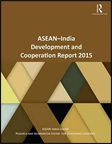 ASEAN-India Development and Cooperation Report 2015Re-engagement between India and ASEAN through increased cooperation across a range of issues, including trade and connectivity, is set to boost prosperity, competitiveness, growth and integration. With negotiations underway to establish a comprehensive free trade area through the Regional Comprehensive Economic Partnership, economic integration between India and Southeast and East Asia is set to scale new heights – further highlighting need for economic corridors with adequate cross-border infrastructure facilities that could facilitate increased production and services networks between ASEAN and Indian economies. This Report brings together experts and researchers who weigh in on ASEAN-India relations, analyzing the impact and implications of integration; assessing policy priorities, effectiveness, implementation imperatives and challenges; and discussing themes central to the economic sustainability of the region. Author: ASEAN–India Centre, Research and Information System for Developing Countries Year: 2015 Download Tags: ASEAN, India, Trade, Trade Facilitation Asian Development Outlook 2015 Supplement: Growth Holds Its Own in Developing AsiaThis Supplement maintains growth forecast for developing Asia at 5.8% in 2015 and 6.0% in 2016. In South Asia, economic outlook remains optimistic, with the region on track to meet Update projections of 6.9% in 2015 and 7.3% in 2016. India's economic expansion balances a slowdown in Bhutan—owing to weaker sales of hydropower—and the Maldives in 2015, and in Nepal in 2016—due to unfavorable weather and unforeseen delays in earthquake-related reconstruction. Growth projections for Bangladesh and Sri Lanka remain in line with those in the Asian Development Outlook Update. Author: Asian Development Bank Year: 2015 Download Tags: ADB, South Asia, Bangladesh, Bhutan, India, Maldives, Nepal, Sri Lanka 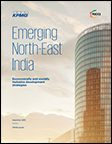 Emerging North-East India: Economically and Socially Inclusive Development StrategiesThis report highlights opportunities that can be explored in India's North East region, including tourism, energy, and infrastructure, to enable the North East to develop economically, while contributing to India's development as a whole. It takes stock of recent initiatives, including the 'Look East' Policy and the Bangladesh-Bhutan-India-Nepal (BBIN) subregional grouping, and identifies areas for improvement to propel inclusive growth. Harnessing the region's full potential would require upgrading the region's infrastructure. Significant investments are needed, since lack of connectivity and inadequate infrastructure present developmental bottlenecks, contributing to the slow pace of growth in the North East. The report presents policy recommendations and suggested actions, and a forecast for India for 2021-2022. Author: KPMG India and FICCI Year: 2015 Download Tags: India, BBIN, Connectivity, Transport, Trade Facilitation Reducing Non-Tariff Barriers to Food Trade Between India and South Asia: Eliminating Phyto-Sanitary and Sanitary IssuesThis brief focuses on the impact of phyto-sanitary and sanitary measures as a significant non-tariff barrier to trade at India's overland trading posts and ports, from which it imports perishable goods from its neighbors in the SAARC region. Due to inadequate facilities to handle large, time-sensitive, and perishable consignments, India and its neighboring trade partners have experienced severe constraints on bilateral trade, which results to variability in time and cost of freight movement, and eventually affects price stability and availability of India's food stocks. Author: Hemant Shivakumar and Shiva C. Sharma Year: 2015 Download Tags: Sanitary and Phytosanitary Measures, India, SAARC, Trade, Non-Tariff Measures, Bangladesh 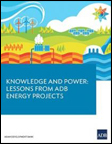 Knowledge and Power: Lessons from ADB Energy ProjectsThis publication highlights good practices and lessons learned from Asian Development Bank projects in energy, which comprised 26.5% of ADB's total lending commitments from 2008 to 2014. It discusses how the region's energy sources are utilized, providing updates on recent developments and challenges, highlighting the need for sustainable energy initiatives. Featured projects include the Green Power Development Project in Bhutan, which developed clean energy for regional use and promoted cross-border power trade. As the first infrastructure-focused public-private partnership in Bhutan, it also illustrated how projects can benefit with the active participation of the private sector, foreign parties, and commercial and public financial institutions. Also featured is the Bangladesh-India Electrical Grid Interconnection Project, which reduced Bangladesh's energy deficiency by enabling the country to affordably import 500 megawatts of electricity from India. This electrical link laid the groundwork for a regional energy market, an important step toward achieving a functioning regional electricity network in South Asia. Author: Asian Development Bank Year: 2015 Download Tags: Energy, Bangladesh, Bhutan, India, Regional Cooperation 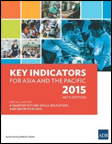 Key Indicators for Asia and the Pacific 2015The Key Indicators for Asia and the Pacific 2015 includes up-to-date available indicators for the 48 regional members of the Asian Development Bank, including numbers on energy, trade, transport, and tourism. Key trends noted in 2014 include the rising volume of intraregional exports globally, due to robust economic growth and expanding regional networks. For Asia and Pacific economies, primary source for merchandise imports was the region itself with a 49.7% share. In energy consumption, Asia and the Pacific now consumes more than 40% of the world's electricity, with the People's Republic of China and India accounting for nearly 70% of the region's output. This 46th edition of Key Indicators also includes a special chapter on skills, education, and growth in Asia, and emphasizes the need to focus on quality and ensure that the workforce has the skills to take the region through economic transition to prosperity. Author: Asian Development Bank Year: 2015 Download Tags: Economic Growth, Energy, Trade, Transport, India Lessons for South Asia from the Industrial Cluster Development Experience of the Republic of KoreaGrowth of manufacturing is crucial for economic growth and poverty reduction. This report highlights the industrial cluster development policy of the Republic of Korea, including its success factors in terms of policy implementation, and the promotion of industrial cluster development, drawing lessons that could enhance industrial growth in South Asia. It discusses how the government encouraged increase in exports through relevant policies and adapted to more technology- and knowledge-intensive industries which required innovation-driven policies. The experience outlined in the report could benefit large-scale industrial promotion in South Asia, such as the Economic Corridor Program in India. Author: Jong-il Kim Year: 2015 Download Tags: South Asia, Industrialization, Economic Corridor, Trade, ADB, India, Bangladesh, Sri Lanka, ADB RCI World Trade Organization Annual Report 2015The World Trade Organization (WTO) Annual Report 2015 provides an overview of WTO activities in 2014 and early 2015. It presents a timeline of two decades of the WTO -- from its origins succeeding the General Agreement on Tariffs and Trade to its current role in the multilateral trading system. It presents a chapter on how WTO helps developing countries build trade capacity and allows them to implement trade agreements. WTO training courses are organized for officials from developing countries each year. Author: World Trade Organization Year: 2015 Download Tags: Trade, Trade Policy, WTO, Tariffs, Energy, Bangladesh, India, Nepal, Sri Lanka, Trade Facilitation, Transport, Asia, Agriculture Building Firm-level Trade Competitiveness in Emerging EconomiesThis paper -- produced under the E15 Initiative and implemented jointly by the International Centre for Trade and Sustainable Development and World Economic Forum -- seeks to understand the framework of competitiveness and its implications for international trade. It discusses issues related to firm-level competitiveness, including the determinants; quality tools and models to address it, especially in developing economies and small and medium enterprises (SMEs); importance of diffusion and learning with a focus on SME growth; and specific policy interventions to improve firm-level competitiveness. Author: Sharmila Kantha Year: 2015 Download Tags: Firms, SME, Trade, Development, Sustainability, India, South Asia, Energy 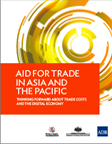 Aid for Trade in Asia and the Pacific: Thinking Forward About Trade Costs and the Digital EconomyAid for Trade (AfT) flows have increased each year since 2006 in Asia and the Pacific. While regional aggregate trade costs continue to fall, many subregions still struggle with trade costs that are substantially higher than the global average. This report highlights and explores how AfT contributed to these emerging trends in Asia and the Pacific and how to continue to address trade costs moving forward. Among the subregions, the Pacific (along with South Asia) has made the greatest improvements in the Logistics Performance Index from 2007-2014. Recent exporter surveys reveal a movement toward niche products and leveraging of e-commerce as a means to overcome cost and distance. Emerging digital technologies such as e-commerce further offers a new set of opportunities for economies in the region to grow through trade. Author: Asian Development Bank Year: 2015 Download Tags: Aid for Trade, Asia-Pacific, ICT, South Asia, Trade, Bangladesh, Bhutan, India, Sri Lanka, Agriculture, Energy, Transport 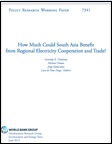 How Much Could South Asia Benefit from Regional Electricity Cooperation and Trade?This paper assesses the potential economic benefits of cross-border electricity cooperation and trade in South Asia from 2015 to 2040. It focuses on the possibilities of unlimited power flow across borders in response to regional demands and investment in generation and transmission to cost-effectively meet those demands. The study quantifies the potential economic benefits that South Asia could reap if the countries engage with full regional electricity trade and cooperation. Among South Asia Subregional Economic Cooperation countries, Bhutan and Nepal have the potential to cost-effectively supply electricity from hydroelectric resources in excess of their own demands; Bangladesh and India are likely to become more dependent on higher-cost coal as well as natural gas to generate electricity. The countries of the South Asia region also have non-coincident demand peaks across the year, implying gains from trade. Author: The World Bank Year: 2015 Download Tags: Energy, South Asia, Trade, Bangladesh, India, SASEC Clean Energy and Access to Infrastructure: Implications for the Global Trade SystemThis paper focuses on how international trade rules could better accommodate renewable energy trade through fixed infrastructure. It explains the World Trade Organization disciplines relevant to trade in clean energy via fixed infrastructure, in particular General Agreement on Trade in Services disciplines on energy services and General Agreement on Tariffs and Trade transit rules. Finally, it suggests policy options to adopt existing rules to the challenges of integrating clean energy transported via fixed infrastructure. Author: International Centre for Trade and Sustainable Development Year: 2015 Download Tags: Energy, Trade, WTO, India, South Asia, Sustainability, Tariff Cross-Border Electricity Cooperation in South AsiaStrengthening cross-border electricity cooperation in South Asia can be part of the solution for providing adequate and reliable electricity. This World Bank Policy Research Working Paper reviews the status of cross-border electricity cooperation in South Asia, identifies key regional-level barriers to expand cross-border cooperation and trade in South Asia, and discusses the extent to which current domestic sector policies impede greater cross-border electricity cooperation. Finally, the findings offer policy recommendations on increased cross-border trade and cooperation. Author: Anoop Singh, Tooraj Jamasb, Rabindra Nepal, and Michael Toman Year: 2015 Download Tags: Energy, Regional Cooperation, Regional Trade, Bangladesh, Bhutan, India, Maldives, Nepal, South Asia, Sri Lanka, Trade, Trade Policy, WB Outward FDI by Indian Manufacturing MNEs: Impacts and Implications This Asia-Pacific Research and Training Network on Trade Working Paper investigates the home country effects of outward foreign direct investment (OFDI) on domestic activity of Indian multinational enterprises (MNEs). The empirical evidence suggests that OFDI by Indian MNEs has a positive impact on export intensity and research and development. In order to derive desired complementary benefits of OFDI by manufacturing firms, policies may be directed to enhance the country’s international supply chain connectivity for greater participation in global value chain and production network. Author: Khanindra Ch. Das Year: 2015 Download Tags: India, FDI, Global Value Chains, Trade, Export, Development, Manufacturing, UNESCAP Together We Deliver 2014: From Knowledge and Partnerships to ResultsThis book includes stories from Bangladesh, India, and Nepal, introducing how ADB has changed people’s lives for the better. It illustrates the innovation and partnerships needed to meet the evolving challenges in Asia and the Pacific. In Bangladesh and India, two ADB projects introduced new approaches in urban governance and development that improved the living conditions of the poor in congested areas. In Nepal, women and other disadvantaged groups were included in the planning of a water and sanitation project that benefited 90,000 households. The 12 uplifting stories in this publication show how partnerships are essential for developing pragmatic solutions to problems, testing and refining approaches, and creating reliable models to scale up benefits for a wider base. Author: Asian Development Bank Year: 2015 Download Tags: Bangladesh, India, Nepal 2015 Annual Evaluation ReviewCountry assessments conducted by an independent evaluation team between CY2010-CY2014, and published in the the Asian Development Bank’s (ADB) 2015 Annual Evaluation Review, show relatively good performance of ADB operations in South Asia. Programs implemented in Bhutan and India, notably, reflected more developed institutional and organizational capacities in ADB sectors of engagement, alongside robust private sector involvement. Nepal and Sri Lanka programs, though affected by civil strife, were also rated successful. This report examines ADB operational performance in 2014, and includes evaluation recommendations. It aims to enhance ADB effectiveness by providing feedback on policies, strategies, operations, and special concerns in Asia and the Pacific. Author: Independent Evaluation Department Year: 2015 Download Tags: ADB, Evaluations, India, Bhutan Connecting South Asia and South East Asia This book analyzes how closer regional connectivity and economic integration between South Asia and Southeast Asia can benefit both subregions. It aims to build a broad case for increased connectivity between the two regions and identify specific projects that have high potential to fulfill this objective. This joint study focuses on both “hard” infrastructure and associated “soft” infrastructure, including tariffs and non-tariff barriers, trade and transport facilitation, energy trading, and infrastructure investment and financing. It further provides a canvas for considering strategic cross-border infrastructure investments and policy reforms. Author: Asian Development Bank Institute and Asian Development Bank Year: 2015 Download Tags: South Asia, Southeast Asia, Connectivity, Economic Corridor, Transport, Trade Facilitation, Bangladesh, India, Sri Lanka 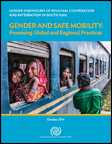 Gender Dimensions of Regional Cooperation in South Asia: Gender and Safe Mobility – Promising Global and Regional PracticesThis technical report analyzes global practices related to gender equality and safe migration, and their applicability to the context of South Asia. "Hard" aspects, such as physical infrastructure and equipment including border infrastructure, passenger holding facilities and surveillance cameras, and "soft" aspects, such as regional, bilateral and/or country-specific policies, programs, mechanisms and institutional linkages of safe mobility, are presented. The report also presents national policies and procedures that promote safe mobility. Given the lessons drawn from the reviewed policies and practices, it highlights the need for stronger evidence-based approaches in understanding the complex experience of women migrant workers, and identifies the need for more regular peer exchange through periodic regional dialogues of key stakeholder groups. Author: International Organization for Migration Year: 2014 Download Tags: Gender, Migration, South Asia, Bangladesh, Bhutan, India, Nepal, Transport, Trade 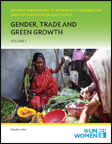 Gender Dimensions of Regional Cooperation in South Asia: Gender, Trade and Green Growth (Volumes I and II)This technical report presents an analysis of the interconnection between gender equality, regional trade and sustainable development in selected areas of four South Asian countries. In general, the report found women's contributions to total exports of all countries to be low, and in green exports to be lower. It identifies constraints and challenges, such as limited training in entrepreneurship, gender stereotypes related to green trade, existing gaps in policy framework, and weak access to technology, hindering women's participation in three green trade industries - agriculture and agro-processing, renewable energy, and ecotourism. The report looks at possible entry points for women, and recommended a list of actions to tap these identified entry points, including the need for greater exchange and cross-fertilization of experience among associations of women entrepreneurs and women’s chambers of commerce in South Asia. Author: Shreyasi Jha, Ritu Dewan, Amee Misra, Saloni Singh, Navanita Sinha, Maheen Sultan and Sonam Tobgay Year: 2014 Download Tags: Gender, Trade, Sustainability, South Asia, Bangladesh, Bhutan, India, Nepal 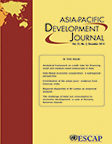 Asia-Pacific Development Journal Vol. 21, No. 2, December 2014The paper "Indo-Nepal Economic Cooperation: A Subregional Perspective" published in this issue of the Asia-Pacific Development Journal (APDJ) explores how subregional engagement among bordering regions can stimulate economic cooperation among countries in South Asia. It assesses the current status and potential of greater integration between India and Nepal, and develops a SWOT (strength-weakness-opportunity-threat) analysis reflecting on the need for a subregional approach to promotion of regional cooperation. APDJ, published twice a year by the Macroeconomic Policy and Development Division of UNESCAP, provides a platform for exchange of knowledge, experience, ideas, information and data on all aspects of economic and social development issues and concerns facing the region. Author: United Nations Economic and Social Commission for Asia and the Pacific Year: 2014 Download Tags: Economic Integration, India, Nepal, Trade, Bangladesh, Sri Lanka, Transport, Trade, Tourism Developing Economic Corridors in South Asia This book describes key conditions for transforming transport corridors into economic corridors and establishes the rationale for developing economic corridors, and the related benefits from production value chains along those corridors. It further emphasizes the significant potential of economic corridors in South Asia, particularly those being developed under the South Asia Subregional Economic Cooperation Program. The chapters highlight the impact of trade barriers on bilateral trade and present case studies on trade facilitation in South Asia. Countries in the subregion would benefit by working closely to exploit the full economic potential of economic corridors. Author: Asian Development Bank Year: 2014 Download Tags: Economic Corridor, South Asia, Trade Facilitation, Bangladesh, India, Sri Lanka, ADB, SASEC, Bilateral Trade, Transport World Tariff Profiles 2014This statistical yearbook devoted to market access for goods contains a comprehensive compilation of tariff parameters for each of the 160 World Trade Organization members, plus a number of other countries and customs territories where data is available. Each country profile presents information on tariffs
imposed by each economy on its imports, including an analysis of market access conditions in its major export markets. Statistics for all countries allow easy comparisons between countries and sectors, as well as between bound and applied tariffs. Author: World Trade Organization, International Trade Centre, and United Nations Conference on Trade and Development Year: 2014 Download Tags: WTO, Customs, Tariff, Bangladesh, India, Maldives, Nepal, Sri Lanka, Transport, Tariffs, Trade SME Competitiveness and Aid for Trade: Connecting Developing Country SMEs to Global Value ChainsThis joint ITC-WTO study discusses constraints faced by small and medium-sized enterprises (SMEs) in international trade, particularly by least developed countries. It reviews how Aid for Trade addresses these challenges through a sample of 23 Diagnostic Trade Integration Studies. Three bottlenecks emerge – quality of business environment, access to finance, and lack of institutional support to overcome trade-related challenges. This study also highlights actions taken by companies to integrate SMEs into their supply chains and concludes with an analysis of recent private sector program evaluations. Author: International Trade Centre and World Trade Organization Year: 2014 Download Tags: SME, Trade, Private Sector, Small and Medium Enterprises, Bhutan, India, Nepal, Sri Lanka, Sustainability Trans-Pacific Partnership versus Regional Comprehensive Economic Partnership: Control of Membership and Agenda Setting This ADB Working Paper argues that the formation of regional integration frameworks can be best understood as a dominant state’s attempt to create its own regional framework where it can exercise some exclusive influence. It explores the Trans-Pacific Partnership and the Regional Comprehensive Economic Partnership (RCEP). It also analyzes the strategies of key players such as ASEAN, Korea, India, Japan, USA and China. India is part of the RCEP negotiating process and sees increased presence in Southeast and East Asian markets, closer relations with ASEAN, and increased connectivity with North Asia and Oceana as benefits from involvement in RCEP. Author: Asian Development Bank Year: 2014 Download Tags: Regional Integration, India, Connectivity, ADB, Regional Cooperation, ASEAN A World Trade Organization for the 21st Century: The Asian PerspectiveThis Asian Development Bank Institute book examines key changes in the world trading system and explores policy implications for Asia. Through a compilation of essays from prominent international and Asian trade experts, this book presents interaction of market forces and trade regulation. Lessons from the Asian experience offer new approaches and economic policies to sustain growth, presenting the World Trade Organization as a forum to improve regional and global trade governance in the 21st century. Author: Richard E. Baldwin, Masahiro Kawai, Ganeshan Wignaraja (Eds.) Year: 2014 Download Tags: Trade, Trade Policy, WTO, Bangladesh, Bhutan, Energy, India, Maldives, Nepal, Sri Lanka, Transport Seaborne Trade between South Asia and Southeast Asia This Asian Development Bank Institute paper examines trade and the main ports around the Bay of Bengal to identify projects that will enable trade and contribute to improved maritime infrastructure. It also reviews the nature of trade and trade patterns, particularly through the Indian East Coast Corridor study. The paper develops further strategic options for seaport adjustment around the Bay of Bengal to support trade evolution, policy assessment, and other constraints. Author: David Wignall, Mark Wignall Year: 2014 Download Tags: Transport, Trade, Ports, ADB, India, Economic Corridor, Bangladesh, Energy, Myanmar, Sri Lanka Regional Transit Agreement in South Asia: An Empirical InvestigationThis discussion paper published by the South Asia Watch on Trade, Economics and Environment assesses the potential gains of a sub-regional transit arrangement and the removal of other border-trade barriers, particularly the eastern South Asia sub-region (Bangladesh, Bhutan, India and Nepal). It also discusses the link between transit and trade flows, provides profiles of intra-regional transit trade and current transit arrangements in South Asia, and identifies efficient regional transit corridors using linear programming or the Data Envelopment Analysis model. Author: Prabir De and Arvind Kumar Year: 2014 Download Tags: South Asia, Trade, Transport, Economics, Economic Corridor, SASEC, SAARC, UNESCAP, Customs, Harmonisation, Bangladesh, Bhutan, India, Nepal, Maldives, Sri Lanka Global Production Networks and Economic Corridors: Can They Be Drivers for South Asia’s Growth and Regional Integration?This Asian Development Bank South Asia Working Paper examines the role of regional and national economic corridors in facilitating access of South Asian countries to global production networks (GPNs), particularly East Asia and Southeast Asia. It also reviews the state of regional trade integration and examines the nature of engagement in South Asia, specifically India, with its dynamic and high growth GPNs. The paper further identifies key factors that constrain engagement of South Asian countries with East and Southeast Asia in GPN trade. Author: Kunal Sen Year: 2014 Download Tags: South Asia, Global Production Network, Economic Corridor, ADB, Regional Integration, India, Bangladesh, Sri Lanka 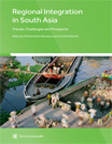 Regional Integration in South Asia: Trends, Challenges and ProspectsThis study presents an assessment of trade and economic cooperation among South Asian nations, explores emerging challenges, and highlights policy issues to foster regional integration. It provides perspectives on potential new areas of cooperation such as investment, regional supply chains, energy, and cross border transport networks. The four areas of focus are: potential gains from South Asian regional integration, key areas for cooperation resulting in effective regional integration, country perspectives of regional cooperation, and case studies on bilateral cooperation. This volume aims to further contribute to policy discourse on effective regional cooperation with perspectives from Bangladesh, India, Maldives, Nepal, Pakistan, and Sri Lanka.
Author: Mohammad A. Razzaque, Yurendra Basnett (Eds.) Year: 2014 Download Tags: South Asia, Regional Integration, Regional Cooperation, Bangladesh, India, Maldives, Nepal, Sri Lanka, Energy UNCTAD Transport Newsletter: Fourth Quarter 2014This United Nations Conference on Trade and Development (UNCTAD) newsletter focuses on the development dimension and benefits of the World Trade Organization Trade Facilitation Agreement. It includes sections on the national trade facilitation committees, project proposal for the implementation of trade facilitation measures contained in the agreement, and improvement in implementation of sanitary and phytosanitary measures to facilitate trade. It also includes UNCTAD’s contribution to trade facilitation in Landlocked Developing Countries and Small Island Developing States. Author: United Nations Conference on Trade and Development Year: 2014 Download Tags: Trade Facilitation, WTO, UNCTAD, Transport, Development, Sanitary and Phytosanitary Measures, Energy, India Statistical Yearbook for Asia and the Pacific 2014The Statistical Yearbook contains comparative statistics and facts about the 58 regional members and associate members of the Economic and Social Commission for Asia and the Pacific. It includes brief analyses of 32 key development features such as energy supply and use, international trade, and transport, among others. In energy, the region’s production structure is highly resource-intensive, although per capita energy use is low. The section on international trade recommends focusing on raising domestic value-added rather than increasing gross exports in Asia and the Pacific. Finally, investment in environmentally sustainable transport is encouraged. Author: United Nations Economic and Social Commission for Asia and the Pacific Year: 2014 Download Tags: Asia-Pacific, Energy, Trade, Transport, Bangladesh, Bhutan, India, Maldives, Nepal, Sri Lanka The Competitiveness of Global Port-CitiesThis book explores the inter-linkages between ports and urban development. It provides an internationally comparative benchmark study of port cities. Case-studies of selected port-cities provide detailed analysis of port performance, port impacts, policies, and governance. The least time-efficient ports are located in Africa and South Asia. Mumbai, India, for example – one of the selected port-city profiles – lacks port infrastructure and suffers from heavy regulation. Author: Organization for Economic Co-operation and Development Year: 2014 Download Tags: Transport, Ports, India NTMs in South Asia: Assessment and AnalysisThe study “NTMs in South Asia: Assessment and Analysis” analyzes how Non-tariff Measures (NTMs) give rise to non-tariff barriers, which are becoming increasingly crucial for advancing trade cooperation among member countries of the South Asian Association for Regional Cooperation, yet remain less-addressed. The study examines export potential and actual export of South Asian countries, and attempts to highlight gains from reduction in transaction costs in bilateral trade. It also notes that initiatives for trade facilitation reforms in South Asia at the regional level remain low in incentives and have yet to produce significant results. The study closes with several recommendations for reducing and eliminating NTMs. Author: Selim Raihan, Mostafa Abid Khan, and Shaquib Quoreshi Year: 2014 Download Tags: Trade Facilitation, Trade, SAARC, Bangladesh, Bhutan, India, Maldives, Nepal, South Asia, Sri Lanka 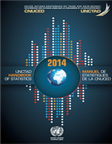 UNCTAD Handbook of Statistics 2014The UNCTAD Handbook of Statistics is a collection of statistics and indicators relevant to the analysis of international trade, investment and development. The 2014 edition shows the increasing convergence of trade balance between developing and developed economies continues. The report also includes regional trade data from South Asia that shows average annual growth rate of international trade improved from a previous deficit of -7.1% in 2012 to -0.1% in 2013. However, trade balance ran a deficit of -26.51% compared to the previous year's -25.94%. Trade indicators also report intra-trade in South Asian Association for Regional Cooperation region rose modestly from US$ 20,219 million to US$ 23,181 million between 2012 to 2013 and maintains intra-regional trade percentage at 5.8%. Author: United Nations Conference on Trade and Development Year: 2014 Download Tags: UNCTAD, Regional Trade, Development, Bangladesh, Bhutan, India, Maldives, Nepal, Sri Lanka, Transport 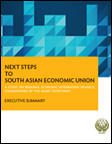 Next Steps to South Asian Economic UnionThis executive summary focuses on Phase II of the study on Regional Economic Integration, commissioned by the South Asian Association for Regional Cooperation (SAARC) Secretariat with the technical and financial assistance of the Asian Development Bank, and outlines a roadmap toward a South Asian Economic Union (SAEU). It presents an overview of intra-regional trade in South Asia—with India accounting for 65% of the region's combined total exports, and Sri Lanka 24% of total intra-regional imports—and discusses specific priority steps, using a phased and planned approach that quantifies potential gains from priority sectors identified in Phase I, needed to achieve regional economic integration. Thus, while non-tariff barriers, infrastructure constraints and other factors continue to challenge regional cooperation and integration in South Asia, reference by SAARC leaders toward an SAEU indicates a willingness to consider bold action. Author: Asian Development Bank Year: 2014 Download Tags: SAARC, South Asian Economic Union, Economic Integration, Bangladesh, Bhutan, India, Maldives, Nepal, Sri Lanka, Regional Integration Bridging Transport, ICT, and Energy Infrastructure Gaps for Seamless Regional ConnectivityThis publication is a contribution by the United Nations Economic and Social Commission for Asia and the Pacific to deliberations at the Second United Nations Conference on Landlocked Developing Countries (LLDCs) in Vienna, Austria, 3-5 November 2014. It shows regional connectivity as an unfinished agenda and bridging infrastructure gaps as a complex challenge for LLDCs. While physical infrastructure is a priority, this report argues that deeper regional integration – through regionally cohesive and terrestrial networks – is key to effectively linking Asian LLDCs to the region’s infrastructure networks. Author: United Nations Economic and Social Commission for Asia and the Pacific Year: 2014 Download Tags: Transport, ICT, Energy, UNESCAP, SASEC, Connectivity, Infrastructure, Bangladesh, India, Nepal, Sri Lanka, Trade, Trade Facilitation, Policy, Trade Policy Review of Maritime Transport 2014The Review of Maritime Transport is an annual UNCTAD flagship publication since 1968. It provides analysis of structural and cyclical changes affecting seaborne trade, ports and shipping, freight markets, and transport and regulatory frameworks. It further presents statistics, data, and insights on ownership of the world fleet, with South Asia dominating the market for ship recycling. This year’s special chapter focuses on the challenges faced by the world’s Small Island Developing States (SIDS) and reviews shipping-related challenges resulting from SIDS size, remoteness, and exposure to natural hazards, including impacts of climate change. Author: United Nations Conference on Trade and Development Year: 2014 Download Tags: Transport, Ports, Small Island Developing States, UNCTAD, Trade, South Asia, Bangladesh, India, Maldives, Sri Lanka Doing Business 2015: Going Beyond EfficiencyThe World Bank Group’s Doing Business Report 2015 is the 12th in its annual series of investigations into regulations that enhance business activity. Its indicators analyze economic outcomes and identify reforms to promote better regulatory frameworks for development, job creation, and growth. For the first time this year, the Doing Business report extends its coverage beyond the second largest city to include economies with a population of more than 100 million such as Chittagong in Bangladesh, and Delhi in India. The data provides insights into the variability of business regulations within economies. Author: The World Bank Year: 2014 Download Tags: Asia-Pacific, Bangladesh, India, Ease of Doing Business, Bangladesh, WB Asian Economic Integration Monitor: November 2014This AEIM review of recent economic performance highlights the need for Asia to rebalance its sources of growth toward domestic and regional demand. It also shows a resilient Asia with rising GDP growth in South Asia. This issue includes a Special Chapter: Regional Financial Integration and Crisis in Asia and Europe – A Comparative Analysis. It presents Asia’s future path of integration as different from that in Europe. Asia will continue to strengthen efforts to harmonize rules and regulations in the financial sector and further unilateral trade and investment, while Europe is more likely to strengthen regional institutions to ensure recovery and better the monetary union. Author: Asian Development Bank Year: 2014 Download Tags: Asia-Pacific, Economic Integration, Europe, ASEAN, Bangladesh, Bhutan, India, Maldives, Nepal, Regional Integration, Sri Lanka, Trade Facilitation, Transport SASEC Website BrochureThis promotional brochure for the SASEC website features the web portal as a one-stop shop for information on SASEC activities, events, projects, and knowledge materials. The SASEC website seeks to build a dynamic discussion platform and repository of data on regional cooperation. Author: Asian Development Bank Year: 2014 Download Tags: SASEC, Knowledge Product, ICT, ADB, Bangladesh, Bhutan, India, Maldives, Nepal, South Asia, Transport, Trade Facilitation, Energy SASEC BrochureThis promotional brochure is a concise introduction to the South Asia Subregional Economic Cooperation (SASEC) Program, highlighting the main areas of regional cooperation and activity. It includes facts and figures about SASEC projects in transport, trade facilitation, energy, and ICT. Author: Asian Development Bank Year: 2014 Download Tags: SASEC, Trade Facilitation, Regional Cooperation, ICT, ADB, Bangladesh, Bhutan, India, Nepal, Maldives, Sri Lanka, Energy, Transport, Connectivity, Myanmar 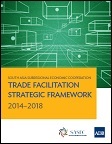 SASEC Trade Facilitation Strategic Framework 2014-2018The South Asia Subregional Economic Cooperation (SASEC) Trade Facilitation Strategic Framework 2014-2018 builds on the momentum of member countries over recent years in forging ahead with many significant improvements to facilitate, and ultimately increase, trade in the subregion and with the rest of the world. It supports the mission of the SASEC Transport and Trade Facilitation Strategy “to promote the prosperity of the subregion by facilitating the efficient movement of trade across the borders”, and focuses on five priority areas: customs modernization and harmonization; standards and conformity assessment strengthening; cross-border facilities improvement; through-transport facilitation; and institution and capacity building. Author: Asian Development Bank Year: 2014 Download Tags: SASEC, Trade Facilitation, Regional Cooperation, Transport, Trade, Customs, Standards, Harmonisation, Regional Integration, ADB, Bangladesh, Bhutan, India, Maldives, Nepal, Sri Lanka, South Asia, ADB RCI World Trade Report 2014 – Trade and Development: Recent Trends and the Role of the WTOThis annual publication highlights the relationship between trade and development, including changes since the start of the millennium. It identifies four key trends that altered the way trade affects development outcomes – accelerated economic growth in developing countries, expansion of global value chains, increase in agricultural and natural resource prices, and global nature of macroeconomic shocks. This report also explores how these trends have reshaped the role of trade in facilitating development and how recent development gains allow developing countries to adapt and mitigate risks. Author: World Trade Organization Year: 2014 Download Tags: WTO, Global Value Chains, Trade, Economic Growth, Agriculture, Trade Facilitation, Development, Bangladesh, Bhutan, India, Maldives, Nepal, South Asia, Sri Lanka South Asia Economic Focus: The Export OpportunityThis bi-annual report presents the recent economic developments, outlook, and policy of the following South Asian countries – Afghanistan, Bangladesh, Bhutan, India, the Maldives, Nepal, Pakistan, and Sri Lanka. It highlights developing country growth as fairly robust. Meanwhile, India’s growth rate is slowly increasing and its inflation rate declining. South Asian economies solidified their external positions by easing pressures to finance current account deficits, yet face domestic challenges such as reducing fiscal risks, supporting higher levels of investment, and sustaining export growth. Author: The World Bank Year: 2014 Download Tags: South Asia, Trade, Economics, WB, Bangladesh, Bhutan, India, Maldives, Nepal, Sri Lanka 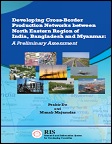 Developing Cross-Border Production Networks Between North Eastern Region of India, Bangladesh and Myanmar: A Preliminary AssessmentThis publication is an extension of an earlier study conducted by the Research and Information System for Developing Countries and presents opportunities in cross-border production networks between North Eastern Region (NER) of India, Bangladesh, and Myanmar. It also explores NER’s growth potential, including the role of trade facilitation in enhancing trade and production networks. Supply-side constraints in the region, as well as bottlenecks to cross-border production links, are further identified through extensive field surveys and structured questionnaires. Finally, this publication argues that logistical efficiency is crucial to production networks between India and Bangladesh, and NER states should be engaged in closer economic integration. Author: Prabir De and Manab Majumdar Year: 2014 Download Tags: India, Bangladesh, Economic Integration, Regional Integration Asian Development Outlook 2014 Update: Asia in Global Value ChainsAs developing Asia continues along a stable growth path, India maintains a 5.5% growth forecast for 2014 and shows promise of a turnaround. Reforms are envisioned for 2015, including a forecast 0.3% upgrade to 6.3%. Bhutan recorded the largest current account deficit as a percentage of GDP, due to imports used in construction of several large hydropower projects that will expand its energy export capacity to India. Meanwhile, South Asia is expected to perform with greater momentum in 2015, with a growth forecast upgrade to 6.1% from 5.8%. Most of the improvements in the subregion are from India’s deficit and Bangladesh’s current account. Nepal also shows improved outlook for 2015. Author: Asian Development Bank Year: 2014 Download Tags: South Asia, Global Value Chains, India, Economics, Trade ASEAN, PRC, and India: The Great TransformationThis joint study by the Asian Development Bank and the Asian Development Bank Institute highlights the Association of Southeast Asian Nations, the People’s Republic of China, and India (collectively referred to as ACI economies) as drivers of the global economy. It explores links among ACI economies and how these may shape regional and global competition and cooperation. The study also notes that Asia’s leading economies can foster a positive outcome through a paradigm shift toward inclusive, green, and knowledge-led growth. Adoption of low-carbon, green growth strategies can help place ACI economies on a sustainable growth path. Furthermore, infrastructure and human capital investments can link ACI economies through region-wide free trade and investment agreements. Author: Asian Development Bank and Asian Development Bank Institute Year: 2014 Download Tags: India, Asia-Pacific, Regional Cooperation, ADB, ASEAN, Investment 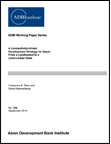 A Connectivity-Driven Development Strategy for Nepal: From a Landlocked to a Land-Linked StateTransforming Nepal from a landlocked into a land-linked state, the authors argue, could be key to unlocking the country's much-awaited growth. With its strategic location between India and the People's Republic of China, a connectivity-driven development strategy could energize Nepal's lackluster post-conflict economic performance. Further, Nepal implements a multi-track approach to promoting regional cooperation and integration in connectivity with its neighbors, reinforced through participation in South Asian Association for Regional Cooperation, Bay of Bengal Initiative for Multi-Sectoral Technical and Economic Cooperation, and South Asia Subregional Economic Cooperation. By identifying ten priority projects that could further boost Nepal's connectivity, the paper also discusses how strengthening Nepal's transport, energy, and trade links could benefit the region. However, the authors also warn against “internal threats” to Nepal's development—corruption and the country's difficult political situation. Author: Pradumna B. Rana and Binod Karmacharya Year: 2014 Download Tags: Nepal, Economic Corridor, Regional Trade, Connectivity, Development, Economic Growth, SASEC, India, Regional Cooperation, Regional Integration, SAARC, BIMSTEC, Transport, Energy, Trade Economic and Social Survey of Asia and the Pacific 2014This 2014 edition of UNESCAP's flagship publication emphasizes the importance of furthering regional connectivity in Asia-Pacific—a region which, despite significant reductions in poverty levels, is now witnessing rising income inequality, both within and between countries. It calls for driving the region's growth by exploiting the interdependence and synergies of five elements: trade and transport connectivity, ICT networks, energy connectivity, people-to-people networks, and promotion of knowledge-based economies, and advocates approaching connectivity as a regional public good. Author: UNESCAP Year: 2014 Download Tags: Economic Integration, Regional Cooperation, Poverty Reduction, Asia-Pacific, Connectivity, Energy, ICT, Bangladesh, Bhutan, India, Maldives, Sri Lanka, Trade, Transport, UNESCAP 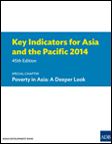 Key Indicators for Asia and the Pacific 2014This year's edition presents an in-depth inquiry on poverty in Asia, tackling whether the $1.25/day extreme poverty standard still accurately depicts minimum living standard of the poor in Asia and the Pacific. Using this broad measure, the poverty rate is projected to fall to 24.5% for South Asia by 2030, if recent economic growth trends continue. However, considering the current national poverty line average among today's less developed economies in the region, an Asia-specific extreme poverty line is more accurately estimated at $1.51/day, increasing Asia’s poverty rate in 2010 by 9.8%, and ��of a large economy like India by 15%. Hence, despite huge gains made, reducing poverty remains a pressing challenge in Asia and the Pacific. This book proposes several measures to counteract worsening poverty, including �close �regional cooperation which can reduce a country’s vulnerability, and urgent policy actions that promote economic growth and prioritize climate change adaptation and mitigation. Author: Asian Development Bank Year: 2014 Download Tags: Poverty Reduction, Disaster Risk, Regional Cooperation, Asia-Pacific, Bangladesh, Bhutan, Economics, Energy, India, Maldives, Milennium Development Goals, Nepal, Sri Lanka, Sustainability, Transport Assessing the Costs of Climate Change and Adaptation in South AsiaThis book discusses the economic costs and benefits of unilateral and regional actors on climate change adaptation in Bangladesh, Bhutan, India, the Maldives, Nepal, and Sri Lanka. It provides the total economic loss throughout the 21st century and estimates the funding required for adaptation measures to avert potential losses. Huge impacts are likely on vulnerable sectors in the region, with South Asia losing on average nearly 2% of its gross domestic product by 2050. Results of the study will aid climate change adaptation in the region, including initiatives for regional cooperation. Author: Mahfuz Ahmed and Suphachol Suphachalasai Year: 2014 Download Tags: Climate, South Asia, Regional Cooperation, Energy, Bangladesh, Bhutan, India, Maldives, Nepal, Sri Lanka Mega-regional Trade Agreements: Game-Changers or Costly Distractions for the World Trading System?This document explores the impact of regional trade agreements such as mega-regionals on countries that are not part of World Trade Organization negotiations. It focuses on trade-diverting effects of Trans-Pacific Partnership and Trans-Atlantic Trade and Investment Partnership such as the potential for multilateralization and discrimination. The report further explores potential impact of mega-regionals on Asia-Pacific, Sub-Saharan Africa, and Latin America. The latter sections highlight the opportunities and challenges in promoting coexistence of these future agreements with the multilateral trading system. Author: World Economic Forum Year: 2014 Download Tags: Asia-Pacific, Regional Trade, Trade Policy, India, WTO 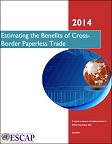 Estimating the Benefits of Cross-Border Paperless TradeCross-border paperless trade is trade that occurs on the basis of electronic communications and has been part of customs reform efforts in a variety of countries. Increased implementation of cross-border paperless trade is high on the trade facilitation agenda in Asia-Pacific. This report considers six measures to calculate estimates of possible economic benefits of cross-border paperless trade through counterfactual simulations using 2013 data and simple econometric models. Simulation results reveal that this new generation of trade facilitation can significantly reduce trade costs and boost intra- and extra-regional trade in the region. Partial implementation of these measures can lead to an export increase of $36 billion annually. Total direct cost savings across all trade is about $1 billion per annum for partial reform, and $7 billion for full implementation. Author: United Nations Economic and Social Commission for Asia and the Pacific Year: 2014 Download Tags: Trade Facilitation, Trade, Asia-Pacific, UNESCAP, Customs, Export, Bangladesh, Bhutan, India, Maldives, Nepal, Sri Lanka 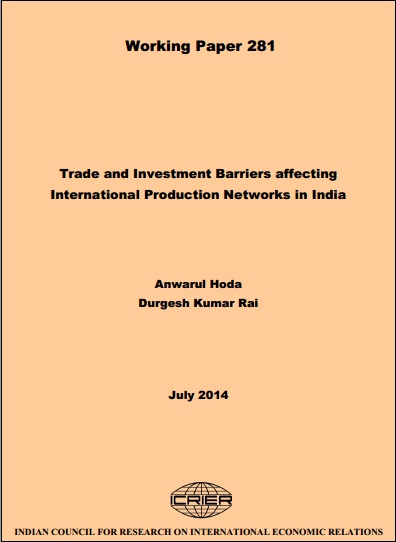 Trade and Investment Barriers Affecting International Production Networks in IndiaRecognizing India as an outlier in development of international production networks with the lowest participation among Asian countries, this study investigates the reason for India’s lackluster participation in production-sharing networks. Using desk work, field surveys, and interviews, an analysis is adopted with three comparator countries in the region that have been successful in production-sharing arrangements as well as industrial growth – China, Malaysia, and Thailand. It further describes foreign direct investment inflows into India, analyzes behind-the-border investment environment, and provides recommendations to improve investment climate and hasten the pace of manufacturing development in India. Author: Anwarul Hoda and Durgesh Kumar Rai Year: 2014 Download Tags: India, Trade, Production Networks, Investment, Thailand, Manufacturing, Customs, Economic Corridor, Energy, Trade Facilitation, Transport The Long and Winding Road: How WTO Members Finally Reached a Trade Facilitation Agreement The conclusion of the Agreement on Trade Facilitation at the Bali negotiations in December 2013 marked the end of a journey that lasted almost a decade. As the first multilateral trade agreement successfully negotiated by World Trade Organization (WTO) ministers, it broke new ground in the decentralized, bottom-up way the negotiations were structured; in the manner the capacities and resources of developing countries were addressed; and in how the Agreement has shifted the system’s focus beyond policy barriers toward process frictions. The negotiated outcome is likely to have an impact not just on Trade Facilitation, but on the WTO and the multilateral trading system as a whole. Author: Nora Neufeld Year: 2014 Download Tags: Trade Facilitation, Trade Policy, Regional Cooperation, WTO, India 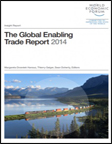 The Global Enabling Trade Report 2014The Global Enabling Trade Report offers a tool to monitor progress on implementing measures for the Trade Facilitation Agreement. Benchmarking the performance of 138 economies in four critical areas, including border administration, the Report takes off from the success of the Bali package by emphasizing measures that facilitate trade at a more practical level, with benefits that significantly outweigh the cost of necessary reforms and produces positive spillover effects on other indicators—market access, infrastructure, and operating environments. Also mentioned are insights on further boosting trade facilitation within the region, such as regional cooperation and sharing of good practices. The Report is intended as a motivator for change at a time of renewed momentum for trade facilitation where windows of opportunities for policymakers to push through trade-enabling measures are open. Author: Margareta Drzeniek Hanouz, Thierry Geiger, Sean Doherty (eds.) Year: 2014 Download Tags: Trade Facilitation, Bangladesh, India, Nepal, South Asia, Sri Lanka 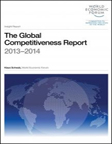 Global Competitiveness Report 2013-2014The World Economic Forum's Global Competitiveness Report offers a platform for dialogue among key stakeholders in government, business, and civil society on improving the living standards of the world’s citizens through insights on institutions, policies, and factors that drive or hinder growth and national competitiveness. Using the Global Competitiveness Index (GCI), twelve pillars are considered, including infrastructure, which, among factor-driven economies of Bangladesh, India, and Nepal, impacts the location of economic activity, reduces distance between regions, and enables production and faster flow of goods. Market size—essential for countries with small domestic markets—is another key index measured. The 2013-2014 report also includes an assessment of newly-covered Bhutan, and an analysis for the drop in India's GCI ranking. Author: Klaus Schwab Year: 2014 Download Tags: Economics, Poverty Reduction, Infrastructure, Bangladesh, Bhutan, Energy, India, Nepal, Sri Lanka, Transport Trade Facilitation and Paperless Trade ImplementationThis paper reports survey findings on progress in implementing various trade facilitation and paperless trade measures made by 29 countries in Asia and the Pacific, including six SASEC member countries. Factors considered include pre-arrival clearance, post-clearance audit, National Single Window, and authorized operator programmes. The survey reveals that while countries have prioritized automation and paperless trade at the regional level, there is an urgent need for regional arrangements that will facilitate cross-border exchange of trade-related electronic documents and information to enable smoother trade facilitation. Author: Tengfei Wang and Yann Duval Year: 2014 Download Tags: Trade Facilitation, Regional Cooperation, Trade, Asia-Pacific, SASEC, Single Window, UNESCAP, Customs, Bangladesh, Bhutan, India, Maldives, Nepal, Sri Lanka WCO News: WTO Trade Facilitation AgreementWCO News is a biannual newsletter of the World Customs Organization (WCO). This issue, released in June 2014, focuses on the World Trade Organization's (WTO) Agreement on Trade Facilitation. WCO's commitment to its implementation is highlighted and linkages between articles of the Agreement and WCO instruments and tools are explored. Also included is a feature on the benefits Authorized Economic Operator programmes bring supply chain companies. Author: World Customs Organization Year: 2014 Download Tags: Trade Facilitation, WCO, WTO, Bangladesh, Customs, India, Sri Lanka 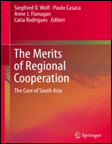 The Merits of Regional Cooperation: The Case of South AsiaThis book makes the case for a re-strengthened South Asian Association for Regional Cooperation (SAARC), arguing that regional integration is a key factor for countries in South Asia to succeed economically and increase confidence among potential foreign investors. SAARC's inroads in improving border crossings, transport routes, and infrastructure are improving weak levels of trade within the region. However, these efforts are insufficient; they need to go hand-in-hand with further improving bilateral relations – and SAARC is in a good position to facilitate these negotiations. Spanning a wide range of subjects, including international relations, strategic affairs, environment, politics and economic issues, the publication aims to show the huge potential of South Asia as a region. Author: Siegfried O. Wolf, Paulo Casaca, Anne J. Flanagan, and Cátia Rodrigues Year: 2014 Download Tags: Regional Cooperation, ASEAN, Bangladesh, Europe, India, SAARC, South Asia 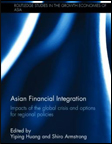 Asian Financial Integration: Impacts of the Global Crisis and Options for Regional PoliciesThe impact of the global financial crisis (GFC) reverberated deeply throughout the financial markets of Europe and the United States. In contrast, due to its relative independence from global financial markets at that time, Asia was sheltered from its painful blow. As the GFC fast-tracked the growth of Asian economies, thrusting them to the center and leading the global recovery, questions about Asia's financial future come up: how can Asian growth and development continue? This book reviews lessons learned from the GFC and looks at important Asian policy responses to the crisis, including capital account liberalization in India. It also attempts to provide a road map for the future, discussing how Asia can strengthen regional institutions and cooperate, while undertaking domestic reforms consistent with the regional and global agenda, and by proposing strategies for financial integration in the region. Author: Yiping Huang and Shiro Armstrong (eds.) Year: 2014 Download Tags: Regional Integration, Economic Integration, Asia, Europe, India 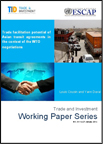 Trade Facilitation Potential of Asian Transit Agreements in the Context of the WTO NegotiationsFreedom of transit is an issue critical to landlocked developing countries whose lack of direct access to the sea has increased costs and lessened their competitiveness in international trade. To meet challenges arising from transit barriers, member states of the United Nations Economic and Social Commission for Asia and the Pacific recommend transit facilitation as part of an integrated approach to trade facilitation.
This working paper analyzes freedom of transit and transit facilitation in the context of trade and transport agreements in the Asia Pacific region, identifying good practices and weighing in on the extent to which existing agreements meet the provisions on transit facilitation stated in the draft text of the World Trade Organization Agreement on Trade Facilitation. Author: Louis Cousin and Yann Duval Year: 2014 Download Tags: Transport Facilitation, Trade Facilitation, WTO, Asia, UNESCAP, Bangladesh, Bhutan, India, Nepal Deepening India’s Shallow Export BasketIndia’s bilateral trade with the People’s Republic of China (PRC) grew to US$70 million in 2011 and growth trajectories suggest that bilateral trade will continue to expand. India exports low value-added products such as ores, cotton, and copper to the PRC; and imports high value-added and technology sophisticated products such as electrical machinery and equipment from the PRC. India suffers from lack of export diversification although manufactures are an increasing share of India’s bilateral export basket. The proposed PRC-India Free Trade Agreement (FTA) can deepen India’s export basket; and FTA-based reforms on pharmaceuticals, and information and technology services sector can significantly impact India’s bilateral trade composition. Author: Asian Development Bank Year: 2014 Download Tags: India, Trade, Trade Policy Unpacking the Bali Package: a Snapshot of Bali Ministerial Decisions of WTO MembersThe Bali Package represents a key turning point for the World Trade Organization. Covering trade facilitation, agriculture, and trade issues for developing and least-developed countries, it is set to increase trade activity on a global scale and lower the cost of doing international trade. This paper acts as a precursor to its implementation by identifying challenges countries may face, giving a brief history of each pillar, exploring the next possible steps for each ministerial decision, and examining the likely effects of this decision/agreement on various other stakeholders, particularly on consumers. Author: Archana Jatkar and Chenai Mukumba Year: 2014 Download Tags: Trade, Trade Facilitation, Trade Policy, WTO, Agriculture, Least Developed Countries, India Together We Deliver: 10 Stories from ADB-Supported Projects Together We Deliver showcases ten ADB projects across Asia and the Pacific that demonstrate clear development impacts, replicable best practices, and valuable use of innovation. Among those highlighted is SASEC's Green Power Development Project in Bhutan, which is boosting the national economy through clean energy exports to India and also funding social programs that bring electricity to more than 8,500 rural poor households. The book also features a rural road project in India that connects remote communities to schools, hospitals, and other facilities. Capturing a wide range of ADB's assistance, the book portrays how ADB is changing for better the lives of many in Asia and the Pacific region. Author: Asian Development Bank Year: 2014 Download Tags: Regional Cooperation, Bhutan, India, Development, Energy SAARC Biz: The Inevitability of South Asia SAARC Biz is a monthly publication of the SAARC Chamber of Commerce & Industry and features a report on the 'Inevitability of South Asia'. While the term 'South Asia' is commonly accepted, it argues that regionalism is far from being implemented on the ground. For instance, SAARC was accepted as a concept of cross-border regionalism but was hobbled due to budget constraints and restrictive mandates. Connectivity across national frontiers is needed to jump-start regionalism and improve lives in the most deprived parts of the Subcontinent. Author: SAARC Chamber of Commerce and Industry Year: 2014 Download Tags: South Asia, Regional Cooperation, SAARC, Industrialization, Regional Integration, Poverty Reduction, Gender, Least Developed Countries, Connectivity, Agriculture, Bangladesh, Youth, India, Environment, Investment, Tourism, Renewables Asian Development Outlook 2014: Fiscal Policy for Inclusive GrowthThe Asian Development Outlook, ADB’s flagship economic publication provides comprehensive macroeconomic analysis in Asia including growth projections by country and region. The Asian Development Outlook 2014 forecasts that developing Asia will grow 6.2% in 2014 and 6.4% in 2015. South Asia remains one of the slowest growing subregions—although growth is forecast to improve by 5.3% in 2014 and 5.8% in 2015. Author: Asian Development Bank Year: 2014 Download Tags: ADB, Bangladesh, Bhutan, Economic Corridor, Energy, India, Maldives, Nepal, Sri Lanka, Transport Simulating World Trade in the Decades Ahead: Driving Forces and Policy ImplicationsThis working paper considers economic prospects up to the year 2100, offering assumptions about key exogenous variables, providing a baseline for climate change policy evaluation, and discussing sectoral and trade issues. The paper combines an economic growth model with a multi-sectoral model to construct scenarios for around 150 countries up to a maximum time horizon of 2035, with forecasts on a number of key variables such as energy prices, demographics, etc. It suggests that trends toward increased regionalization may be reversed, with multilateral trade relationships gaining in importance. Author: Lionel Fontagné, Jean Fouré and Alexander Keck Year: 2014 Download Tags: Climate, Trade, Statistics, Trade Policy, Policy, Energy, Tariff, ASEAN, India, Environment 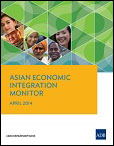 Asian Economic Integration Monitor - April 2014The Asian Economic Integration Monitor, a semiannual review of regional economic cooperation and integration in Asia covers regional economic updates, intraregional trade, financial integration and investment, and the importance of disaster risk financing instruments. The Theme Chapter: Insuring Against Asia’s Natural Catastrophes discusses market solutions and the role of government in developing disaster risk financing and strengthening financial resilience. The economic update section encourages strengthening regional cooperation in surveillance and financial safety nets, and deepening economic links. Inter-subregional trade between each subregion and the rest of Asia is rising, except in South Asia, while financial integration continues to deepen across the region. Author: Asian Development Bank Year: 2014 Download Tags: Regional Cooperation, Regional Integration, South Asia, Disaster Risk, Climate, Bangladesh, Bhutan, India, Maldives, Nepal, Sri Lanka, Transport 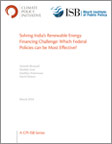 Solving India’s Renewable Energy Financing Challenge: Which Federal Policies can be Most Effective?As India works toward increasing the use of renewable energy across the country, unsubsidized renewable energy remains 52-129% more expensive than conventional energy and needs policy support. This joint publication by the Climate Policy Initiative and Indian School of Business weighs in on federal policies that can provide a solution to India's renewable energy challenge, and asks whether existing support policies are the most cost effective.
Various policies are assessed, in light of the different criteria federal policymakers consider. Existing federal policies are compared with a recommended class of debt-related federal policies using a suggested framework. The study concludes that long-term, debt-related policies are more cost-effective. The research also presents viable short-term policy options. Author: Gireesh Shrimali, Shobhit Goel, Sandhya Srinivasan, David Nelson Year: 2014 Download Tags: Energy, Climate, India Lose to Gain: Is Involuntary Resettlement a Development Opportunity?This book examines how displaced persons recover from physical and economic displacement in the South Asian context using resettlement case studies from India, Nepal, and Sri Lanka. Despite improvement in national policies and willingness to enforce good practices, the level of involuntary resettlement good practices in South Asia varies widely. There is need for greater commitment, legal reforms, and adequate resources to ensure that involuntary resettlement becomes a development opportunity for all project-affected persons. Author: Perera, Jayantha (ed.) Year: 2014 Download Tags: India, Nepal, South Asia, Resettlement, Bangladesh, Energy, Renewables, Sri Lanka, Transport Asian Market Development and Integration: Challenges and OpportunitiesThis book, co-published by Asian Development Bank (ADB) and Korea Capital Market Institute (KCMI), in collaboration with the Peterson Institute for International Economics, examines the path of capital market development in Asia since the 2008 global crisis. It presents the analytical framework for addressing capital market integration at the regional level and its likely impacts. Author: Asian Development Bank (ADB) and Korea Capital Market Institute(KCMI), eds. Year: 2014 Download Tags: Economics, Trade Policy, Regional Integration, Bangladesh, Bhutan, India, Maldives, Nepal, Sri Lanka Who Shapes Climate Action in India? Insights from the Wind and Solar Energy SectorsThis report discusses climate change as a problem with domestic and international dimensions that intersect in complex ways. It focuses on the main players - including government, private sector, and civil society - by attempting to understand their influence in shaping climate change within India. Wind and solar sectors are highlighted as renewable energy is an important part of the energy mix and there has been remarkable activity in these sectors in recent years. The case studies describe key discourse and perceptions influencing renewable energy policy and the central questions shaping climate policy in India. Author: Ankur Chaudhary, Ankita Narain, Chetan Krishna and Ambuj Sagar Year: 2014 Download Tags: Climate, Energy, India Potential Growth in Emerging AsiaThis paper estimates potential growth for China, India, and five ASEAN countries during 1993-2013. It states that India has exhibited a slowdown in potential growth, reflecting a decline of total factor productivity growth. The paper also puts forward that demographic factors will be much more supportive in the future as the working-age population starts to decrease. Author: Rahul Anand, Kevin Cheng, Sidra Rehman, Longmei Zhang Year: 2014 Download Tags: Economics, India, ASEAN, Trade 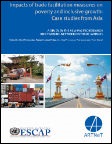 Impacts of Trade Facilitation Measures on Poverty and Inclusive Growth: Case Studies from Asia - A Study by the Asia-Pacific Research and Training Network on TradeThis book addresses the gap between trade facilitation and poverty reduction and contains a compilation of specific case studies that explores the linkages between trade facilitation measures and poverty. It also presents cross-country analysis that examines inequality in low- and middle-income countries. Other chapters discuss economic corridors and microfinance development as trade facilitation measures and examine access to trade facilitation by export-oriented micro, small, and medium-sized enterprises. It also explores barriers to international entrepreneurship for the vegetable business in Bangladesh. Finally, it offers a comprehensive evaluation of the effectiveness of Export Processing Zones (EPZs) on poverty reduction. Author: Ravi Ratnayake, Rajan Sudesh Ratna, Martina Francesca Ferracane and Yann Duval Year: 2013 Download Tags: Trade Facilitation, Bangladesh, Trade, Poverty Reduction, Economic Corridor, Small and medium enterprises, India, SAARC, Customs, Pakistan 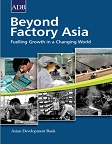 Beyond Factory Asia: Fuelling Growth in a Changing WorldThis paper assesses the challenges of Factory Asia – a model of regional networks connecting production centers in different Asian economies. It forms part of regional and global value chains and constitutes an important source of growth in the region. Regional cooperation is vital to the success of Factory Asia, which calls for greater South-South cooperation to leverage knowledge in domestic manufacturing, allowing countries such as India to leapfrog to higher value chains. For Bangladesh and Sri Lanka with small domestic markets, strategic options include carving out a niche in lower-value manufacturing. The paper further argues that policymakers should be wary of expanding or increasing the number of free trade agreements for the growth or spread of production networks. Author: Asian Development Bank Year: 2013 Download Tags: South Asia, Regional Cooperation, Trade Policy, Manufacturing, Exports, Small and medium enterprises, India, Agriculture, Bangladesh South Asia Energy Security: Challenges and OpportunitiesThe imbalance between the growing demand for energy in South Asia and the countries' uneven energy resources has led to weakened energy security in the region. Import dependence from outside the region has become a costly solution. As countries in South Asia move to expand their economies, fostering cross border energy trade and promoting energy investment opportunities could be a better alternative to resolving the energy deficit. However, energy cooperation within South Asia is challenged by major issues that could impede regional energy trade that is beneficial for all. Author: Bhupendra Kumar Singh Year: 2013 Download Tags: Energy, South Asia, Bangladesh, Bhutan, India, Nepal, Pakistan, Sri Lanka, Trade, Hydropower Reducing Poverty by Closing South Asia's Infrastructure GapThis report takes a critical look at inter-and intra-regional infrastructure of South Asia and explores inequality of access across space and time. It gives an approximate total cost of regional infrastructure needs and investment trends in the South Asia region, along with a proposed framework on ranking of infrastructure needs. The report also examines better usage of existing resources and policy options to help the poorest gain better access to infrastructure.
Finally, it recognizes the enormity of infrastructure deficiencies in South Asia and acknowledges that a good mix of infrastructure investment and supportive reform implementation will enable the region to close the infrastructure gap. Author: Luis Andrés, Dan Biller, and Matías Herrera Dappe Year: 2013 Download Tags: Transport, South Asia, Infrastructure, Energy, Roads, Railway, Water Supply, Bangladesh, Bhutan, Nepal, India, Sri Lanka, Maldives 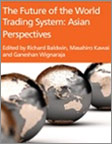 The Future of the World Trading System: Asian PerspectivesAccording to WTO Director-General Pascal Lamy, the problems facing Asian regionalism are a scaled-down version of the problems facing the world. Thus, solutions that address Asia’s noodle bowl would most likely work at the global level. This concise collection of short chapters is based on longer papers presented at the Geneva Conference on 11-12 March 2013, organized by the Asian Development Bank Institute and Centre for Trade and Economic Integration at the Graduate Institute of International and Development Studies, in collaboration with WTO. The chapters are written by leading Asian and international trade experts on key changes taking place in the world trading system and its policy implications for Asia. Author: Richard E. Baldwin, Masahiro Kawai, and Ganeshan Wignaraja, eds. Year: 2013 Download Tags: Regional Integration, Trade Policy, Trade, Global Value Chains, Global Production Network, Regional Trade, Trade Facilitation, India UNCTAD Handbook of Statistics 2013This UNCTAD Handbook of Statistics provides essential data for analyzing and measuring world trade, international financial flows, investment, and development. It documents the south-south trend led by developing Asia and reveals how exports among developing countries remain centered in the Asian region. The share of south-south trade in total world exports doubled over the last 20 years to over 25 per cent. Apart from The People's Republic of China and other major petroleum and gas exporters, India is among the countries that have most expanded their south-south trade during the last two decades. Author: United Nations Conference on Trade and Development Year: 2013 Download Tags: South Asia, Statistics, Trade, India The ASEAN Economic Community: A Work in ProgressThis publication explores the barriers and impediments to the realization of an ASEAN Economic Community (AEC), and to what extent its self-imposed deadline of 2015 for achievement of an AEC is more of a milestone of progress than a firm target. It examines whether the AEC is achievable, the obstacles faced in achieving it, and the measures required to help it become a reality. Author: Asian Development Bank Year: 2013 Download Tags: Regional Cooperation, Regional Integration, Trade Policy, ASEAN, Economic Integration, Regional Cooperation, ADB, Regional Integration, Services, Global Value Chains, Non-Tariff Measures, Asia-Pacific Trade Agreement, India, Trade Facilitation ADB Regional Cooperation Operations Business Plan (RCOBP) 2014-2016 for South AsiaADB's third Regional Cooperation Operations Business Plan (RCOBP) 2014-2016 for South Asia under its South Asia Regional Cooperation Strategy (RCS) 2011-2015 details a cumulative indicative lending program of $3.3 billion and maintains focus on improved regional connectivity, increased cross-border trade, and strengthened regional economic cooperation. Author: Asian Development Bank Year: 2013 Download Tags: Regional Cooperation, Regional Integration, Bangladesh, Bhutan, India, Maldives, Nepal, Sri Lanka, Trade Facilitation, Transport, Energy, SAARC Deepening Economic Cooperation between India and Sri LankaThis book analyzes the performance and impact of the India-Sri Lanka free trade agreement over the past decade and suggests the way forward. India became an important source of imports for Sri Lanka immediately after the implementation of the free trade agreement. Author: Asian Development Bank Year: 2013 Download Tags: Regional Cooperation, Trade Policy, India, Sri Lanka, Trade, Economic Cooperation, India-Sri Lanka Free Trade Agreement, Free Trade Agreements, Services, Trade Facilitation, Exports, Import Financing Low-Carbon UrbanDevelopment in South Asia: A Post-2012 Context The cities of South Asia are growing at an unprecedented rate. Currently, the region
accounts for 5 of the world's 26 megacities (Delhi, Dhaka, Karachi, Kolkata, and
Mumbai),with Kolkata and Mumbai being the most dense. The urban population in
India is expected to increase by 20.8 percentage points between 2010 and 2050 compared
to 7.8 percentage points in Latin America and the Caribbean. These trends necessitate bold
efforts in project design and financing to steer this rapid urbanization onto an inclusive, green,
and low-carbon urban development path. Author: Asian Development Bank Year: 2013 Download Tags: Climate, Energy, India, South Asia, Kyoto Protocol, Bangladesh, Bhutan, Nepal, India, Maldives, Sri Lanka Financing Low-Carbon UrbanDevelopment in South Asia: A Post-2012 Context The cities of South Asia are growing at an unprecedented rate. Currently, the region
accounts for 5 of the world's 26 megacities (Delhi, Dhaka, Karachi, Kolkata, and
Mumbai),with Kolkata and Mumbai being the most dense. The urban population in
India is expected to increase by 20.8 percentage points between 2010 and 2050 compared
to 7.8 percentage points in Latin America and the Caribbean. These trends necessitate bold
efforts in project design and financing to steer this rapid urbanization onto an inclusive, green,
and low-carbon urban development path. Author: Asian Development Bank Year: 2013 Download Tags: Climate, Energy, India, South Asia, Kyoto Protocol, Bangladesh, Bhutan, Nepal, India, Maldives, Sri Lanka Aid for Trade: An Investment Benefit Road Map for South AsiaAid for Trade (AfT) came to prominence just over a decade ago at the launch of the
World Trade Organization's Doha Round. With its focus on helping least developed
countries and economies escape the poverty trap, it aims to strengthen their
capabilities to meet market demand and to reduce supply-side constraints such as a lack of
trade infrastructure. Author: Asian Development Bank Year: 2013 Download Tags: Trade Policy, Poverty Reduction, Infrastructure, India, Bangladesh, Bhutan, Maldives, Sri Lanka, Nepal, Trade Facilitation, Transport, Global Value Chains, Exports Energy Outlook for Asia and the Pacific: October 2013The Energy Outlook for Asia and the Pacific aims to support ADB energy sector operations
by providing stakeholders with an energy outlook for the region up to the year 2035.
It attempts to identify policy, social, infrastructure, and technology issues that must be
addressed to meet future energy need of ADB members in Asia and the Pacific. Author: Asian Development Bank Year: 2013 Download Tags: Energy, Infrastructure, Renewables, Hydropower, Transport, Bangladesh, Bhutan, India, Nepal, Maldives, Sri Lanka Climate Action South Asia: Information Update No. 3 (The Economics of Climate Change in South Asia: Adaptation and Impact Assessment)Analyses show that the cost of early action on climate change in South Asia is lower than
the cost of damage brought about by climate change impacts. In physical terms, the region
will face water shortage and agricultural food production losses, which are vital to achieving
poverty reduction and other Millennium Development Goals (MDGs). Author: Asian Development Bank Year: 2013 Download Tags: Economics, Climate, Agriculture, Climate Change, Environment, South Asia, Milennium Development Goals, Sustainability, Bangladesh, Bhutan, India, Nepal, Maldives, Poverty Reduction, Hydropower, Energy 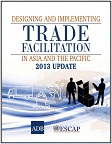 Designing and Implementing Trade Facilitation in Asia and the PacificThis reference book was published to support the implementation of trade facilitation measures and reforms in Asia and the Pacific. It includes operational guidance on assessing the status of trade facilitation, the measures and reforms needed, how to design trade facilitation initiatives, and how to implement them at national and regional levels. The book is intended to assist policy makers, practitioners, and economists by bridging the gap between theory and practice. The revised 2013 version includes updated statistical figures and data, information on actual trade facilitation policies and practices, and the most recent research on trade facilitation. Author: Asian Development Bank / United Nations Economic and Social Commission for Asia and the Pacific Year: 2013 Download Tags: Trade Facilitation, Regional Cooperation, Regional Integration, Trade Policy, Economic Corridor, Sanitary and Phytosanitary Measures, Technical Barriers to Trade, Revised Kyoto Convention, Customs, Customs Valuation, Bangladesh, Bhutan, India, Nepal, Maldives, Sri Lanka, Services Asia-Pacific Trade Facilitation Forum: Survey on Trade Facilitation and Paperless TradeConducted jointly by the Asian Development Bank and the United Nations Economic and Social Commission for Asia and the Pacific, this survey provides a status snapshot of trade facilitation in place across 26 countries of the region, including progress towards establishment of national trade facilitation committees, implementation of risk management measures, development of national single windows, and steps taken to move toward paperless trade. It further examines specific issues and challenges in these areas of South East Asian countries, and provides recommendations for improvement. Author: ADB and UNESCAP Year: 2012 Download Tags: Trade Facilitation, Paperless Trade, Bangladesh, Bhutan, India, Nepal, Maldives, Sri Lanka, Customs, Transport Facilitation, Myanmar, National Single Window Unlocking Bangladesh-India Trade: Emerging Potential and the Way ForwardThis working paper breaks down the importance of trade cooperation between Bangladesh and India by taking a closer look at the impacts of Bangladesh's increased market access to India, and their improved border connectivity. Employing data from national government resources and multilateral development organizations including the International Monetary Fund, World Bank, and World Trade Organization, the study provides an estimate of the trade potential of Bangladesh and India, and calculates the implications on costs of trade facilitation, among others. It also discusses ongoing challenges in bilateral relations and provides recommendations that will enable larger gains for the two contiguous countries. Author: Prabir De, Selim Raihan, and Sanjay Kathuria Year: 2012 Download Tags: Trade, Trade Facilitation, Regional Cooperation, Bangladesh, India, WB, WTO, Bilateral Trade Regional Integration and Economic Development in South AsiaSouth Asian leaders have made it a priority to tackle key regional issues such as poverty, environment degradation, trade and investment barriers and food insecurity, among others. This book considers the leadership of the South Asian Association for Regional Cooperation (SAARC) and the interaction with civil society in the process of South Asian regional cooperation and integration, and discusses how the emerging urgency in the provision of regional public goods provides an excellent opportunity to add to the successes in South Asian regional integration. Author: Sultan Hafeez / Rahman Sridhar Khatri / Hans-Peter Brunner Year: 2012 Download Tags: Economic Corridor, Regional Cooperation, Regional Integration, SAARC, SAFTA, Bangladesh, Bhutan, India, Maldives, Nepal, Sri Lanka Sector Roadmaps with Result FrameworksSector roadmaps with result frameworks for transport, energy, and trade facilitation. Author: Asian Development Bank Year: 2011 Download Tags: Trade Facilitation, Energy, Transport, Bangladesh, Bhutan, India, Maldives, Nepal, Sri Lanka Regional Cooperation and Integration Through Cross-Border Insfrastructure Development in South AsiaThis paper aims to identify the links between cross-border infrastructure development and poverty reduction. With South Asia being home to around 40% of the world's poor, there is a great need to boost intraregional trade through greater cooperation and integration. Regional integration promises to increase the region's capacity to connect with global production networks and participate in the global economy with greater efficiency. Author: P.V. Srinivasan Year: 2011 Download Tags: Regional Cooperation, Regional Integration, South Asia, Bangladesh, Bhutan, India, Maldives, Nepal, Sri Lanka, Poverty Reduction South Asia- Intra Regional Cooperation: The Way ForwardThis study aims to showcase the benefits of regional integration and recommends strategies for overcoming the many hurdles. Author: Shahid Kardar Year: 2011 Download Tags: Policy, Economic Cooperation, Regional Integration, Development, SAARC, Non-Tariff Measures, Trade Facilitation, SAFTA, India, Bangladesh, Bhutan, Maldives, Nepal, Sri Lanka, BIMSTEC, Myanmar, SASEC, Energy 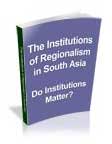 The Institutions of Regionalism in South Asia - Do Institutions Matter?This paper assesses the contribution of key institutions of regional cooperation and integration (RCI) in South Asia, and suggests ways in which the Asian Development Bank and other development partners can strengthen their support. It attempts to enhance understanding on the interplay between politics and RCI, including how good bilateral political relations or improvements have advanced RCI. With the overall political environment growing increasingly open to RCI, the paper suggests the time has come for the South Asian Association for Regional Cooperation (SAARC) to consider strengthening the capacity of the SAARC Secretariat to meet the growing challenges and work load of managing the anticipated increase in RCI. Author: Prabhu Ghate Year: 2011 Download Tags: Regional Cooperation, Regional Integration, Development, SAARC, Trade, Services, Trade Facilitation, Energy, Free Trade Agreements, SAFTA, Bangladesh, Bhutan, India, Maldives, Nepal, Sri Lanka, Transport Energy Trade in South Asia: Opportunities and ChallengesThe South Asia Regional Energy Study was completed as an important component of the regional technical assistance project Preparing the Energy Sector Dialogue and South Asian Association for Regional Cooperation Energy Center Capacity Development. It involved examining regional energy trade opportunities among all the member states of the South Asian Association for Regional Cooperation. The study provides interventions to improve regional energy cooperation in different timescales, including specific infrastructure projects which can be implemented during these periods. Author: Sultan Hafeez Rahman / Priyantha D. C. Wijayatunga / Herath Gunatilake / P. N. Fernando Year: 2011 Download Tags: Energy, Regional Cooperation, Regional Integration, SAARC, Trade, Bangladesh, Bhutan, India, Nepal, Maldives, Sri Lanka The Provision of Regional Public Goods in South AsiaThis report reviews the provision of high priority regional public goods (RPGs) selected
for the South Asia subregion, and proposes areas of cooperation for improving the provisioning of RPGs in South Asia. It highlights the issues in cross border management of infrastructure projects and best practices in the provisioning of RPGs relevant for South Asia, evaluates ADB’s contributions to providing RPGs in the subregion, and concludes with recommendations on ADB’s South Asia Regional Department’s role in the provision of RPGs in the subregion. Author: Khaja Moinuddin Year: 2010 Download Tags: Energy, Agriculture, Disaster Risk, Governance, Poverty Reduction, Bangladesh, Bhutan, India, Maldives, Nepal, Sri Lanka, Trade Facilitation, Transport Binding Contraints to Regional Cooperation and Integration in South AsiaThis paper examines the benefits of regional cooperation and integration, focusing on the cost of neglecting to address the binding constraints to regional cooperation and integration. Component papers in this volume analyze the current state of play, and identifies the binding constraints to achieving more efficient transport corridors, regional energy trade and trade facilitation in the region. Author: Gilberto M. Llanto Year: 2010 Download Tags: Regional Cooperation, Economic Integration, Trade Facilitation, Energy, Bangladesh, Bhutan, India, Maldives, Nepal, Sri Lanka, Transport Infrastructure for a Seamless AsiaThe study reviews regional infrastructure being enhanced through regional cooperation in Asia and examines major issues and challenges. It suggests a framework for pan-Asian infrastructure cooperation, anchored on a long-term vision of creating a seamless Asia that will not only enhance the region's competitiveness and extend its global reach, but also help reduce poverty and promote greater environmental sustainability. Author: Asian Development Bank / Asian Development Bank Institute Year: 2009 Download Tags: Regional Cooperation, Regional Integration, Transport, Trade Facilitation, Connectivity, India, Bangladesh, Bhutan, Nepal, Maldives, Sri Lanka, Asian Highway, Trans-Asian Railway Network, Energy, Myanmar Pan-Asian IntegrationIn today's globalized world where the economic fates of nations are inevitably linked, weathering the present economic storm for Asia will increasingly depend on harnessing regional dynamics particularly on the trade front. Pan-Asian Integration: Linking East and South Asia is a rich volume of perspectives from leading thematic experts on regional patterns of trade and investment, trade-related infrastructure, trade facilitation, among others. Author: Asian Development Bank Year: 2009 Download Tags: Regional Cooperation, Regional Integration, Trade Policy, Transport, Trade Facilitation, Economics, India, Free Trade Agreements 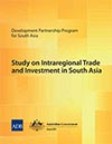 Study on Intraregional Trade and Investment in South AsiaThis study broadens and deepens intraregional cooperation and integration in trade and investment among South Asian countries. It showcases the benefits of regional integration and presents an array of policy recommendations to maximize and realize such gains. Three parallel initiatives are needed: first, reduce nontariff barriers to deepen the South Asian Free Trade Area (SAFTA); second, expand SAFTA's scope to include investments and services; and third, focus on key industries to succinctly demonstrate the process and benefits of reforms. These translate into six component studies: (i) the Role of Trade Facilitation in South Asian Economic Integration; (ii) Country Investment Studies for Bangladesh, India, Nepal, and Sri Lanka; and (iii) Textile and Clothing Industry. The study invigorates the debate and focus on South Asian integration as a means to further growth and reduce poverty. Author: Asian Development Bank / Australian Government Year: 2009 Download Tags: Trade Policy, Trade Facilitation, Regional Cooperation, Regional Integration, Bangladesh, India, Nepal, Sri Lanka, SAFTA Quantification of Benefits from Economic Cooperation in South AsiaThe study examines the implication of the South Asian Free Trade Agreement (SAFTA) on South Asian countries and on the region as a whole, employing both a quantitative and qualitative assessment on the outcomes of SAFTA. The research aims to provide support in the formulation of concrete policy measures for trade to ensure greater gains for the region, while at the same time mitigating potential negative impacts. Economic and social assessments through analytical tools and rational causal chain analysis further enrich the study. Author: Asian Development Bank / United Nations Conference on Trade and Development Year: 2008 Download Tags: Economic Corridor, Regional Cooperation, Regional Integration, SAFTA, Free Trade Agreements, Trade Facilitation, Transport, Services, SAARC, Bangladesh, Bhutan, India, Maldives, Nepal, Sri Lanka Emerging Asian Regionalism-A Partnership for Shared ProsperityThe study summarizes important issues related to Asian regionalism. Viewing regional cooperation as a necessary tool for coping with the consequences of interdependence, the book discusses several pressing issues, such as integrating production, improving financial cooperation, and managing macroeconomic interdependence to create a stable architecture for an Asia-wide cooperation. Author: Asian Development Bank Year: 2008 Download Tags: Economic Corridor, Regional Cooperation, Regional Integration, Asia, ASEAN, SAARC, Bangladesh, Bhutan, India, Nepal, Maldives, Sri Lanka SASEC ICT Development Master PlanThis report represents the first comprehensive multilateral ICT development plan. Its primary objective is to create a framework that will support the already existing ICT plans of Bangladesh, Bhutan, India, and Nepal and help these SASEC countries collaborate more effectively with each other. Author: Asian Development Bank Year: 2006 Download Tags: ICT, Regional Cooperation, Regional Integration, SASEC, Bangladesh, Bhutan, India, Nepal Management Development and Institution Building in SASEC CountriesThe study identifies challenges in management development in the four SASEC countries by comparing institutional development in Bhutan, Nepal, and Bangladesh universities with the experience of the Indian Institutes of Management (IIMs). It discusses long-term strategies and alternatives to strengthen the management development capacity in the region and support private sector needs. Author: Sushil Khanna Year: 2004 Download Tags: Development, India |



